

The Daily Iowan
WEDNESDAY, OCTOBER 9,
Expanded conference, expanded opportunity
The Big Ten’s adoption of four PAC-12 teams offers a chance for regional styles to prove themselves amid increased travel within the larger conference.
Matt McGowan
Pregame Editor matt.mcgowan@dailyiowan.com

Washington football safety Kamren Fabiculanan was fielding questions with ease. Sitting at the podium inside Lucas Oil Stadium in Indianapolis, the well-dressed and bespectacled Fabiculanan delved into how the Huskies were responding to their new head coach and defensive coordinator.
But when asked by a Daily Iowan reporter how many cities in the state of Iowa he could name off the top of his head, the safety kept his answer succinct.
“Iowa. That’s it,” he said with a smile.
Hailing from Camarillo, California, the defensive back grew up more than 1,800 miles from Kinnick Stadium. A trip from his Washington campus to the Iowa Pentacrest is a 27-hour drive. For most of his life, Fabiculanan had no reason to know anything about Iowa or the Midwest. For his first five years with the Huskies, the senior most likely viewed the Big Ten as a potential bowl game opponent — not a conference foe to prepare for every week.
Yet such is the case in the 2024-25 college football season, where former PAC-12 squads Washington, Oregon, USC, and UCLA will compete in an 18-team Big Ten Conference complete with a longer season, more travel, and a plethora of unfamiliar experiences. Football and Olympic sports student-athletes, coaches, and administrators
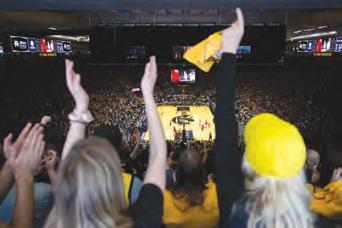
Evan Watson News Reporter news@dailyiowan.com
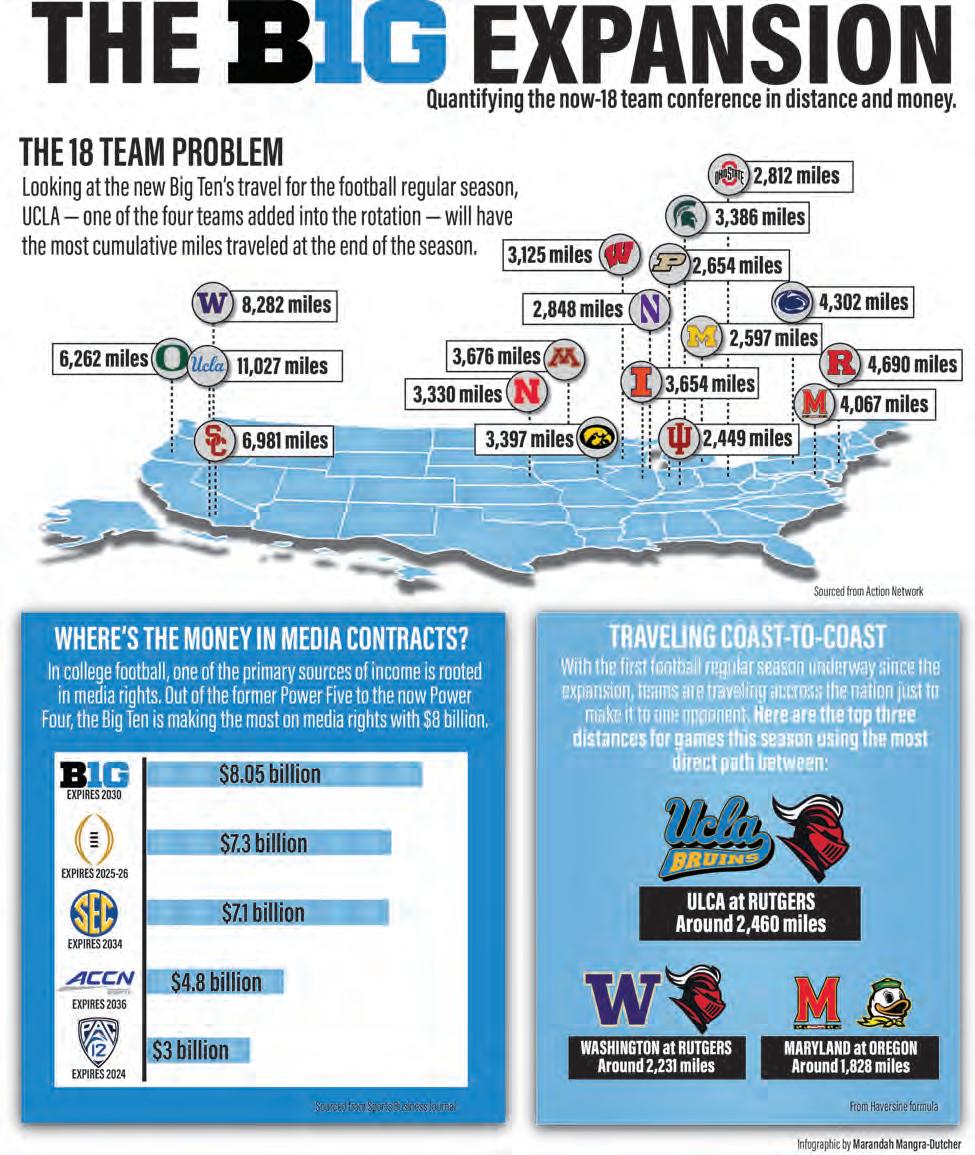
are left to navigate this new landscape and embrace it for its challenges but also its unprecedented opportunities.
From Power Five to Power Four
The additions of the four West Coast schools started on June 30, 2022, when USC and UCLA were granted admittance to the Big Ten via a unanimous vote by conference presidents and chancellors. The two schools would officially make the transition on Aug. 2, 2024.
A water buffalo that was freely roaming through the backyards of residents in Des Moines just one month ago has found a new home at the Iowa Farm Sanctuary near Oxford, Iowa.

Named Phil, the water buffalo lives there with two other water buffalo, Jane and Sal, who were all to be slaughtered by an Iowa resident with a history of mishandling livestock. Phil escaped confinement during transit, and public outcry landed him and the others in Johnson County. However, water buffalo are not prevalent in the state of Iowa.
The Iowa Farm Sanctuary is a nonprofit farm animal rescue shelter that provides lifetime housing to the animals it rescues. The farm is located northeast of Oxford and has been open since 2015.
The sanctuary hosts both public and private farm tours and scheduled visits in a seasonal format. Their visiting period ends in mid-October. They care for various farm animals, including pigs, chickens, sheep, an elderly ram, and others.
When Phil escaped confinement in Des Moines, he was featured in several publications while the Des Moines police and Blank Park Zoo attempted to track him down as he wandered through residential areas and parking lots.
Iowa Farm Sanctuary Executive Director Shawn Camp said Phil was found in a bank parking lot. Phil’s then-owner had informed the police and the public that Phil was a dangerous animal, so when police encountered him, they
Iowan’s
Above
dailyiowan.com.
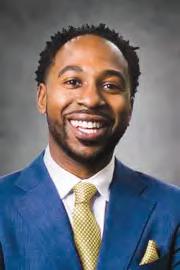
For UCLA Athletic Director Martin Jarmond, the national stage of the Big Ten offered student-athletes a way to capitalize on their name, image, and likeness. “We want to position our student-athletes at UCLA to be the best and to be in a position of strength,” Jarmond said in a 2022 interview on SportsCenter. “We have 119 BIG TEN | 2A
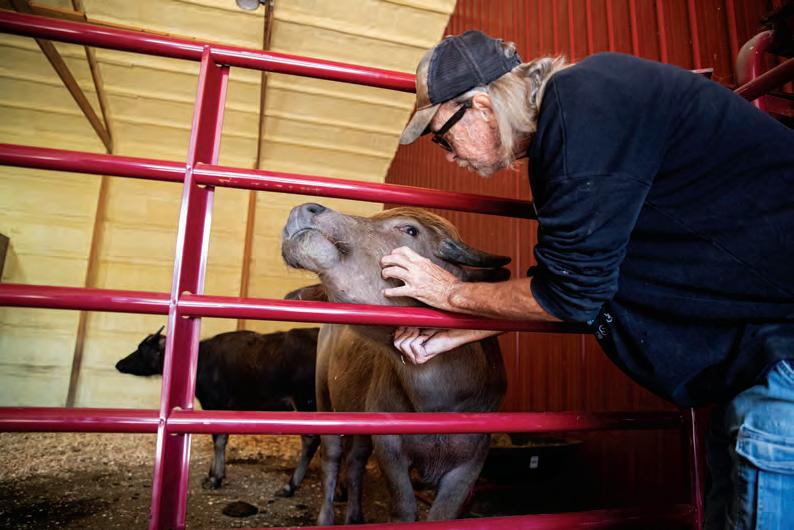
Mediterranean restaurant opens in Old Capitol Mall
Two days later, Phil was spotted, and Iowa
Jordan Barry | The Daily Iowan Lead volunteer and educator of the Iowa Farm Sanctuary Kevin Recknor scratches Phil the water buffalo’s chin inside a barn near Oxford,
Fabiculanan
Jarmond
national championships, and it’s important to sup port all 25 of our programs. At the end of the day, with this seismic change in col lege athletics, we want to be in a position of strength at UCLA, and that’s what we intend to do.”
For the Trojans and Bruins — who had been with the PAC-12 since 1922 and 1928, respec tively — the move was a stark break of tradition but offered the lucrative luxury of reaping in a share of the new Big Ten media rights deal. The PAC-12’s $3 billion deal with ESPN and FOX was set to expire at the end of the 2023 season, and the conference was still in the process of finding a future suitor.
The Big Ten’s agree ment — spanning seven years and shelling out $7 billion from NBC, FOX, and CBS — was signed on Aug. 18, 2022. USC and UCLA would each receive a piece of the pie, which ESPN’s Adam Rittenberg and reported would be between $80-$100 million a year. That share would dwindle a little more than a year later as Oregon and Washington jumped ship on Aug. 4, 2023. That same day, fellow PAC-12 schools Arizona, Arizona State, Utah, and Colorado joined the Big 12. The PAC-12 was down to two teams — Oregon State and Washington State — and left scrambling for a media rights deal.
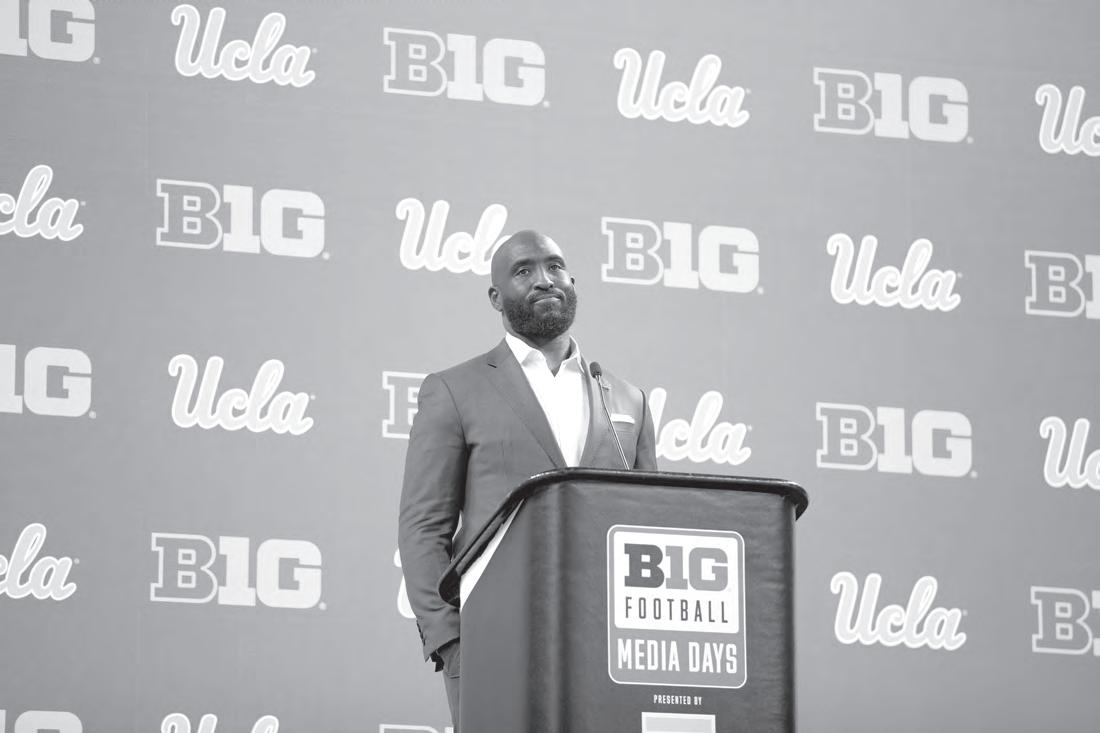
The PAC-12 would eventually sign a one-year deal with FOX and The CW in May 2024 and will add new teams in the future.
Former Mountain West schools Boise State, Colorado State, Fresno State, Utah State, and San Diego State are set to join in the summer of 2026, as will former West Coast Conference powerhouse Gonzaga, which doesn’t have a football team but is known for its talent in basketball.
When college football kicked off the 2024-25 season, the Power Five — a term used to describe the NCAA premier Division I conferences — was now the Power Four, with the Big Ten as an 18-team superconference complete with a sharp uptick in quality competition.
On the gridiron, all four of the incoming schools had winning records in 2023, with Oregon and Washington battling in the PAC-12 title game in December.
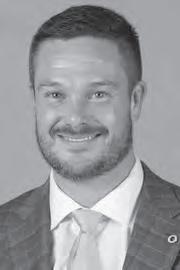
Despite its coach leaving for the Alabama job in the offseason and star quarterback Michael Penix Jr. departing to the NFL, Washington is 4-2 and 2-1 in Big Ten play. The Ducks boasted the second-best offense in the nation in 2023, averaging 44.2 points and 346.9 yards per game.
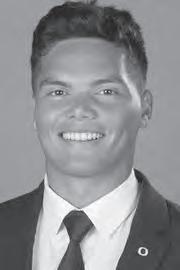
Head Coach Dan Lanning made a splash in the transfer portal, signing Oklahoma quarterback Dillon Gabriel for his final season of college eligibility. Gabriel ranks 16th in the nation in passing efficiency, completing 77.8 percent of his passes for 1,449 yards and 11 scores as the Ducks have broken out to a 5-0 mark this season.
Oregon ranks No. 3 in the nation in the most recent Associated Press poll, while USC and UCLA are unranked.
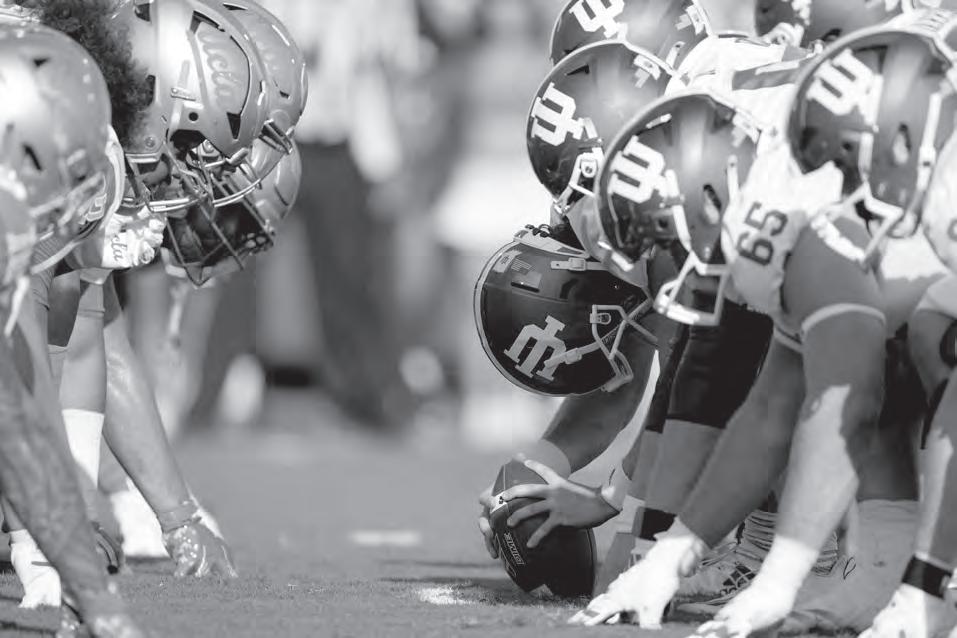
The Trojans picked up an impressive road win against LSU in Week 1, but have struggled on the road against Big Ten foes, dropping decisions to Minnesota and Michigan. Meanwhile, UCLA and new head coach Deshaun Foster have dropped five straight contests by a combined 20.75 points. Despite the four new schools’ varying degrees of success, they are each united in the challenge of travel.
Coast-to-coast action
According to a study from Ben Mendelowitz of Action Sports Network, UCLA will travel the second-farthest for any Division I football team this fall, totaling 11,027 miles across its 12 regular season games. The Bruins have played road matchups against Hawaii, LSU, and as part of their Big Ten slate, will fly out east to Penn State, Rutgers, and Nebraska.
Out of the top 10 schools in mileage, the Big Ten features the second most, trailing the Mountain West. Behind UCLA is Washington in fifth place with 8,832 miles and USC following with 6,981. Sitting at No. 13 is Oregon, which will fly 6,262
Every Big Ten school falls within the top 110, with 13 of the 18 institutions sitting in the top 75.
For second-year conference commissioner Tony Petitti, building schedules is a collaborative process involving coaches, university administrators, and even Big Ten leadership at the presidential level.
“We’ve taken a lot of care to try to minimize travel where we can,” he told reporters at 2024 Big Ten Football Media Days in July. “I will tell you that we feel really good about where we’ve ended up across all of our sports.”
“Having said that, I really believe that scheduling is something that has to be constantly evaluated by sport, and I anticipate that we’ll get, hopefully, a lot more right these next couple of years with the way we’ve formatted and scheduled,” he continued.
“But it’s our responsibility and our job to listen to student-athletes, to listen to coaches to make sure that we’re adjusting and making the changes we need.”
Petitti said it would be reasonable to assume future alterations, but based on testimony from head coaches and administration, the extra travel doesn’t pose too much of a burden.
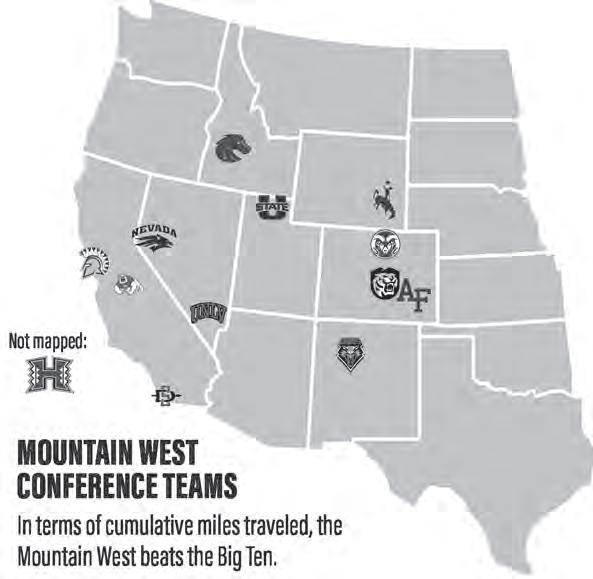
In an August interview with The Los , UCLA Athletic Director Jarmond said travel would be “incremental, not seismic.” He noted that most sports will have one or two trips per year to a dif -
ferent time zone. The Bruins football team has five trips to a different time zone — Hawaii, Penn State, Rutgers, LSU, and Nebraska — but only three take place during the UCLA school year.
“It’s individualized, so we worked with our UCLA sleep clinic, bringing doctors into the process to guide us,” Jarmond said in the interview. “They’re going to provide detailed guidance on departure times, dates, and sleep scheduling for teams. They’re also providing overall sleep education to coaches and staff. So that’s going to be individualized and ongoing, based on the team.”
For Iowa football, the Hawkeyes will travel 3,397 miles this season — ranking 69th in Division I and 10th in the Big Ten — hitting two different time zones in November trips to Maryland and UCLA. The trip to the West Coast during the regular season will be a rare one for the Hawkeyes, who last ventured out there in 2010, when they went to Tucson in September for a matchup against Arizona.
For Paul Federici, now in his 16th year as director of football operations at Iowa, in-season travel out
TEN | 4A
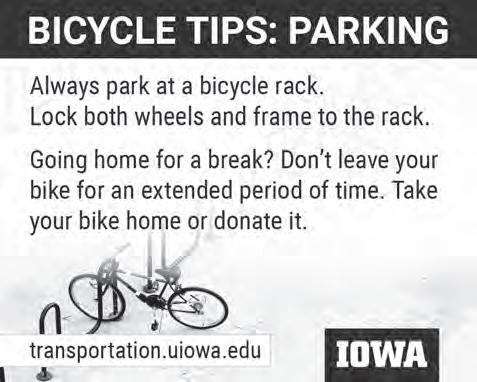

Lanning
Gabriel
Isabella Tisdale | The Daily Iowan
UCLA coach Deshaun Foster listens to a question during day two of Big Ten Football Media days at Lucas Oil Stadium in Indianapolis on July 24. Coaches and athletes from Iowa, UCLA, USC, Michigan State, Nebraska, and Penn State answered questions from the media.
Kirby Lee | Imagn Images
Sep 14, 2024; Pasadena, California, USA; UCLA Bruins and Indiana Hoosiers helmets at the line of scrimmage during the game at Rose Bowl. This was the first match-up with one of the expansion teams in the new 18 team Big Ten.
BIG
LOCATION OF IOWA FARM SANCTUARY
The sanctuary is

Phil was rounded up, evaluated and transported to the farm sanctuary. Surprisingly, the bullet is still inside Phil, but Camp says it has walled off, and no lead is present in his blood.
Camp said the farm sanctuary has a dedicated community of supporters and that, as Phil’s situation unfolded, they were receiving emails about him.
“By Saturday morning, we had an inbox full of messages about him,” she said.
The farm then posted on social media to signal Iowa State that they could take Phil in if he was safely captured.
Media outcry was substantial, Camp said, as shirts sold out for Phil and people got tattoos.
Camp said Phil’s original owner, Prem Nepal, bought the animal and three other water buffalo in Kansas before bringing them to the Des Moines area, where he planned to slaughter them for their meat, an unusual practice considering water buffalo are lean animals.
Nepal slaughtered one, and Phil escaped in transit before he was to be slaughtered. Phil’s situation landed him in the sanctuary’s care, but sanctuary Animal Caretaker Laura Wiederholt said Nepal did not own the land where he was operating, a fact that led to the sanctuary acquiring the other two animals.
As Phil was running around Des Moines, the landowner discovered Nepal’s practices and evicted him from the
customer service-based. I really like taking care of people, that’s why I’ve always been in customer service, and easily the best form is food, because everybody loves food,” Singh said. “There’s just a different feeling that I get when I’m serving food to people and they’re enjoying it.”
A key aspect of Zolly’s is their diverse and unique menu. The restaurant features a mix between Mediterranean and American food and even combines them for one of their specialty dishes called the Gyro Burger. Other menu highlights include rib tips, Philly cheesesteaks, and Munster cheese curds.
The menu also includes a section of Halal and vegetarian foods that the owners hope to expand over time. On the first day of opening, they only had one option, and after nine days, they added more than 10 options.
Singh explained that it’s a goal of theirs to
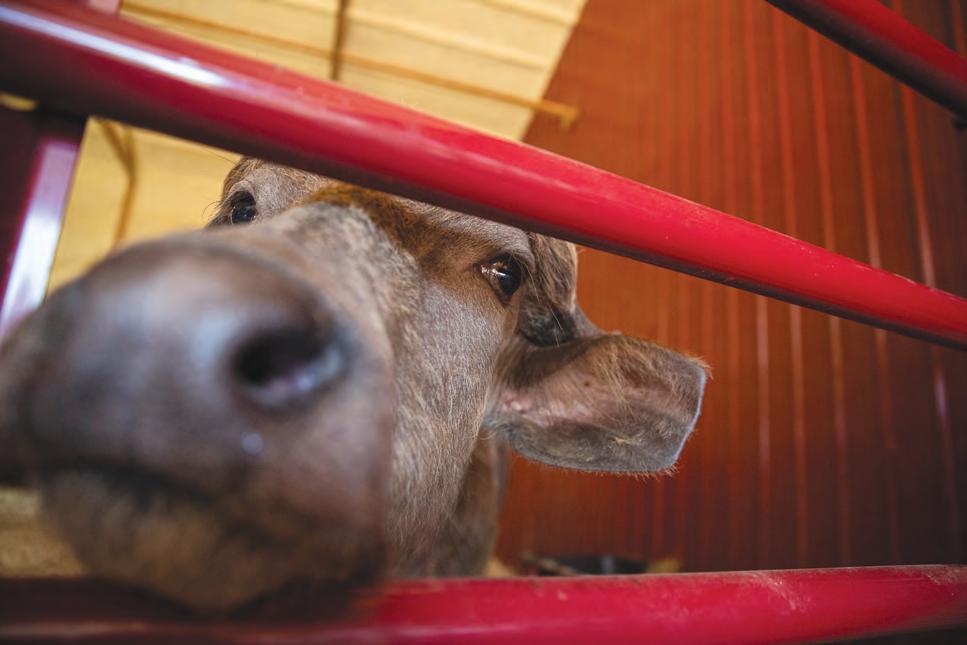
property, which left Nepal with nowhere to keep the remaining water buffalo.
Phil was turned over to the sanctuary, where he was reunited with Jane and Sal, who were taken there after Nepal had nowhere to put them, Wiederholt said.
Wiederholt said she and other employees were expecting the worst.
“With the amount of public outcry that happened, it became a minor national news story, and I think public pressure definitely made all the difference,” she said.
Sanctuary Manager Katie Valentine, who handles administrative work and sometimes works directly with the animals, said that media influence helped significantly. She said Phil likely would have been euthanized when he was found if it were not for the expansive media coverage.
be available to everyone, and they will work to grow their menu in tandem with their restaurant.
The owners also said keeping their prices reasonable for customers was a major priority. Sood said the expensive nature of the food industry makes it inaccessible and they wanted to keep their food at a reasonable price. Sood and Singh are also former college students from the University of Iowa and Iowa State University, so they know the struggle some college students face with money.
“I think restaurants keeping prices down in such a student-heavy area can bring in so much business. It’s nice to hear places are taking price into account,” second-year UI student Brynn Pietzsch said.
Sood also stressed the desire to connect with their customers.
“We want to be more of a community restaurant where we know the people and the people know us,” she said.
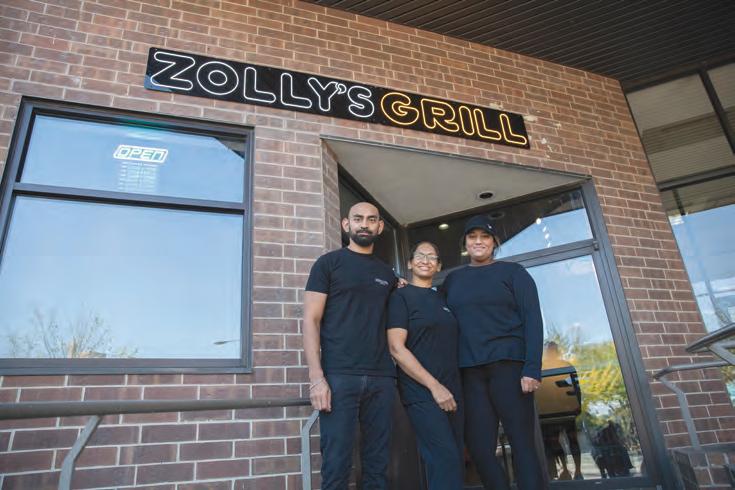


AMANDA JONES
In That Librarian Amanda Jones maps the book banning crisis occurring all across the nation, drawing the battle lines in the war against equity and inclusion.
October 19, 10am Meeting Room A Iowa City Public Library

Valentine said she and the rest of the staff are glad Phil is alive and healthy, along with his friends Jane and Sal.
“We’re thrilled with the outcome that he’s here,” she said.
The staff at the Iowa Farm Sanctuary are learning the proper care techniques for water buffalo, Valentine said, since they are not native to Iowa.
“We’ve been researching water buffalo care because we’ve had no prior experience with them,” she said.
“They’re a hot climate species, so we’ll see how they fare in the wintertime.”
Phil is currently in the farm’s medical wing, a division of its large livestock barn. Within a week, Phil and his friends will be turned out to pasture if his medical evaluations are clear and he has no lead present in his blood.
Phil’s former owner has been charged with having an animal at large.
Featuring:

LITERARY LEGENDS: TRACY KIDDER Tracy Kidder reflects on his lengthy literary career and reads from some of his bestselling work. The Pulitzer Prize winner will be in conversation with fellow Iowa Writers’ Workshop alum Stuart Dybek. October 15, 7:30pm Iowa Memorial Union Main Lounge
FORREST GANDER Pulitzer Prize-winning poet Gander’s new novel-poem, Mojave Ghost takes readers to his birthplace in the Mojave Desert and his current northern California home, where tumultuous memories coalesce with the present. October 19, 1:30pm Prairie Lights Books


JENNIFER CROFT Award winning literary translator Jennifer Croft’s debut novel, The Extinction of Irena Rey, is a hilarious, thought-provoking tale that is a brilliant examination of art, celebrity, the natural world, and the power of language. October 19, 10:30am Prairie Lights Books
ARI BERMAN
Berman, the national voting rights correspondent for Mother Jones, will present Minority Rule: The Right-Wing Attack on the Will of the People—and the Fight to Resist It. October 19, 2:30pm Meeting Room A Iowa City Public Library

Jordan Barry | The Daily Iowan
Phill the water buffalo is seen inside a barn at the Iowa Farm Sanctuary in Oxford, Iowa on Sept. 25. Phil gained national attention after roaming the Des Moines area.
buffalo, currently resides.
Map by Emily Pavlik | The Daily Iowan
Capitol Mall.
ZOLLY’S from 1A
Isabella Tisdale | The Daily Iowan
(Left to right) Sarabjit Singh, Kashmir Sood, and Annie Sood stand in front of Zolly’s Grill in the Old Capitol Mall in Iowa City on Oct. 5. Zolly’s Grill recently moved into the Old Capitol Mall after years of working in Waterloo, Iowa.
Map by Emily Pavlik | The Daily Iowan
west poses its own set of challenges.
For instance, the team will leave the morning before its contest against UCLA, and the lights-out time the night before games is usually 11 p.m. CT.
Federici said if the team doesn’t adjust to the different time zone, then that would be 1 a.m., but if they do, that time would shift to 9 p.m. — times both deemed unreasonable.
Another hurdle involved in the trip to Pasadena will be delivering equip ment, which for typical road trips in the Midwest is delivered via truck two days before game day. This time around, that truck will likely leave on Tuesday for a cross-country trip through the Rocky Mountains.
“The logistics of getting everything there and back will be assembled quite differently than even a trip to Maryland would look,” Federici said. “That trip rep resents something anticipated that we’ve not yet experienced.”
Federici said Iowa’s traveling squad, which contains up to 74 players as opposed to the 100-plus on the active roster, will get back to campus around 6 a.m. the following morning after the bat tle with the Bruins.
This is not ideal from a sleep and recov ery perspective, Ferderici noted, but he added that the bye week afterward pro vides a respite before the Hawkeyes go to Maryland the following week.
For PAC-12 teams heading to the Midwest, preparation will also be key. Washington football’s head coach Jedd Fisch said he and the Huskies would make the trip up to Iowa City on Thursday ahead of the Saturday 11 a.m. Central kickoff.
The Big Ten announced one of its goals is to ensure that a school plays all 17 other conference foes at least twice, home and away, within a five-year period.
“That’s a heck of a jigsaw puzzle for somebody or some computer algorithm to put together,” Federici said.
In the context of the Big Ten’s expansion, even the nature of football has come under scrutiny.
Regional styles
The PAC-12 has been known for Air Raid offenses where passing is routine. Iconic “PAC-12 After Dark” games have point totals stretching near triple digits. For instance: a Sept. 21, 2019, contest between UCLA and Washington State where the Bruins emerged with a 67-63 victory.
The teams’ two quarterbacks combined for 1,077 passing yards on 66 completions — no overtime needed.
In a 2021 study from Pro Football Focus, contests between two PAC-12 teams averaged 59.5 total points since 2014, a whole touchdown lower than the Big Ten. In 2023, the PAC-12 sported six of the top 50 squads in the FBS in terms of points per game compared to the Big Ten’s three. That year, PAC-12 teams averaged 29.7 points per game while the Big Ten averaged 23.7 points.
Nebraska offensive lineman Ben Scott has experienced both sides of the coin, having played at Arizona State for three seasons before transferring.
After starting 11 games for the Cornhuskers last season, Scott said he has a fair idea of what makes Big Ten football unique.
The center explained how the conference features more 12-13 personnel groupings, wherein two or three tight ends line up on the line of scrimmage to serve as extra blockers in run plays.
If a team wants any success, it will have
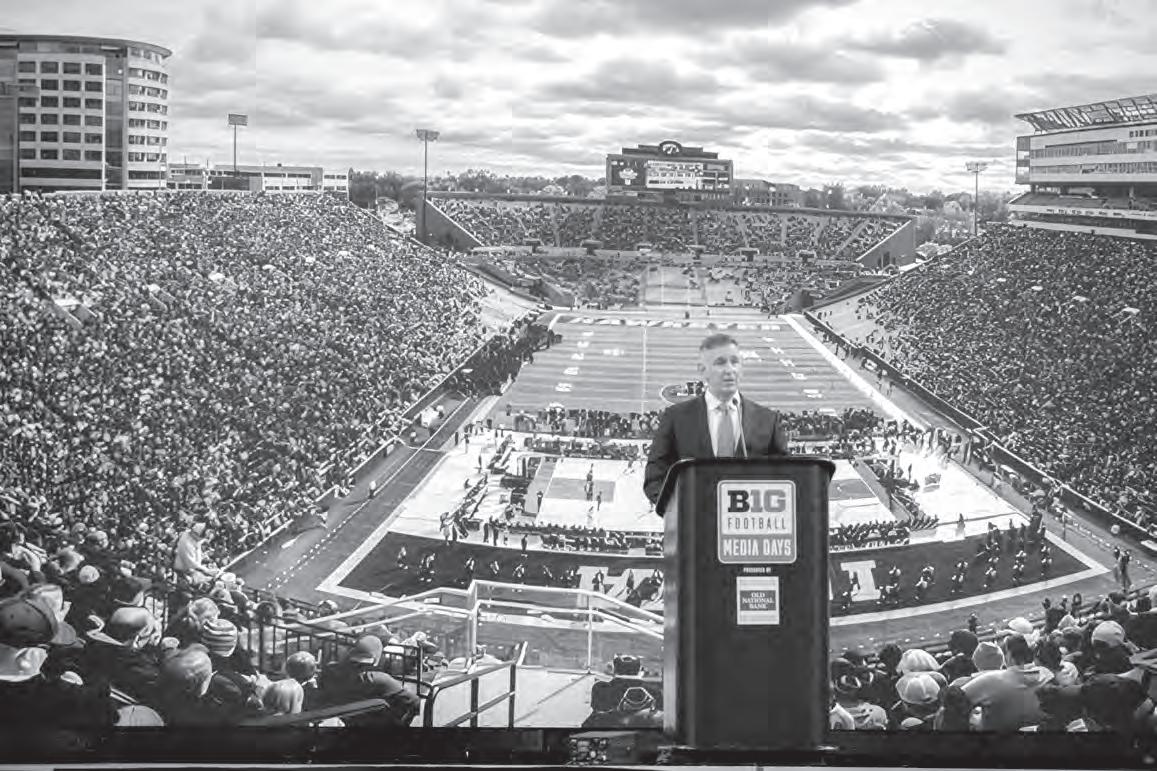
to stop this strategy again and again.
“It’s a game of inches in the Big Ten,” Scott said at Big Ten Football Media Days. “We’ve got a lot of big guys lining up, a lot of big D-linemen, a lot of big O-linemen.”
Washington running back Jonah Coleman said he is aware of the stigmas of West Coast football, where defense and physicality are not as emphasized as they are in the Midwest.
Hailing from Stockton, California, the junior has grown up with the PAC-12 but doesn’t view football as too much of a regional game.
“At the end of the day, it’s football. You put on your cleats and lace them up just like me,” he said. “We both know that at the end of the day, it’s going to be a battle of who wants it more and who worked the hardest.”
upcoming matchup with the Bruins. “Get ready for some Big Ten ball.” Olympic sport impact
While the Big Ten’s conference expansion has made a seismic impact on the football world, smaller Olympic sports also have to deal with new competition and schedules. Unlike football, these sports play multiple games during the week and do not have bye weeks to separate long trips.
“At the end of the day, it’s football, you put on your cleats and lace them up just like me. We both know that at the end of the day, it’s going to be a battle of who wants it more and who worked the hardest.”
Jonah Coleman Washington running back
Part of the reason for style contrasts between the Big Ten and PAC-12 is the weather.
It is difficult to throw 40-yard spirals in negative temperatures with wind gusts of more than 20 miles an hour.
So, when teams like UCLA make a trip to Nebraska in November, they might be in for a rude and chilly awakening compared to.
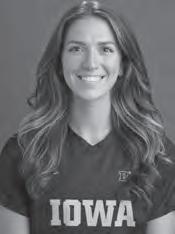
Bruins quarterback Ethan Garbers has known sunny skies and calm breezes his whole life, having grown up in Newport Beach, California.
He said the coldest weather he’s ever played in was 50 degrees, and that number is sure to drop this season.
“It’s going to be good,” Scott said of the
For Iowa women’s soccer head coach Dave Dilanni, his initial reaction to expansion was one of excitement. USC and UCLA have combined for two of the last five NCAA titles, and Dilanni said Washington and Oregon are hot spots for young talent in recruiting circles.

The Hawkeyes have recent history with the PAC12 as well, having battled a then-nationally-ranked UCLA twice in the last five seasons.
Graduate student goalkeeper Macy Enneking was on hand for both of these contests and remembers the Bruins not just for their talent, but also their distinct style embodied by other teams on the West Coast.
“Midwest soccer is a lot more team-oriented, a lot more physical and gritty,
whereas West Coast is a lot more of a direct play style,” she said. “I think they depend more on talent-based individuals. They’re very quick and fast up top, whereas I think Big Ten in particular focuses more on our defensive style of play and more build-up.”
Aside from his excitement, Dilanni said he had initial concerns with travel logistics but added that those feelings were relieved fairly quickly.
Even though he said he had no involvement in schedule-building outside of recommendations, Dilanni said he was satisfied with how the conference managed to coordinate 18 teams traveling cross-country.
Rather than making a trip to both coasts in the same year, the head coach explained how these long trips would alternate each year. For instance, the Hawkeyes venture to Rutgers this season but host Washington and Oregon, whereas next year, they head out to California for matchups against USC and UCLA.
For Dilanni, it’s important to keep perspective in conference expansion. After all, his first season at the helm was when Maryland and Rutgers joined the Big Ten. Although the opposition improves, the strategies don’t. If anything, they’re more amplified.
“You try to replicate as much as you can in the direction you’re going but also prepare your body to give yourself the best chance to succeed,” he said. “Hydration, nutrition, sleep patterns. All of those things matter.”
While it’s easy to view conference expansion through the lens of football, Olympic sports are still along for the ride, and Dilanni hopes that his team and others can receive some benefits.
“Certainly there’s a money element to why this expansion is happening, so you hope that you should see at least something in that context,” he said. “I’m pretty flexible and inclusive in how I think about things. As long as [the Big Ten] can take care of the scheduling and the money can be distributed to these athletes, then I think it can be a great thing.”
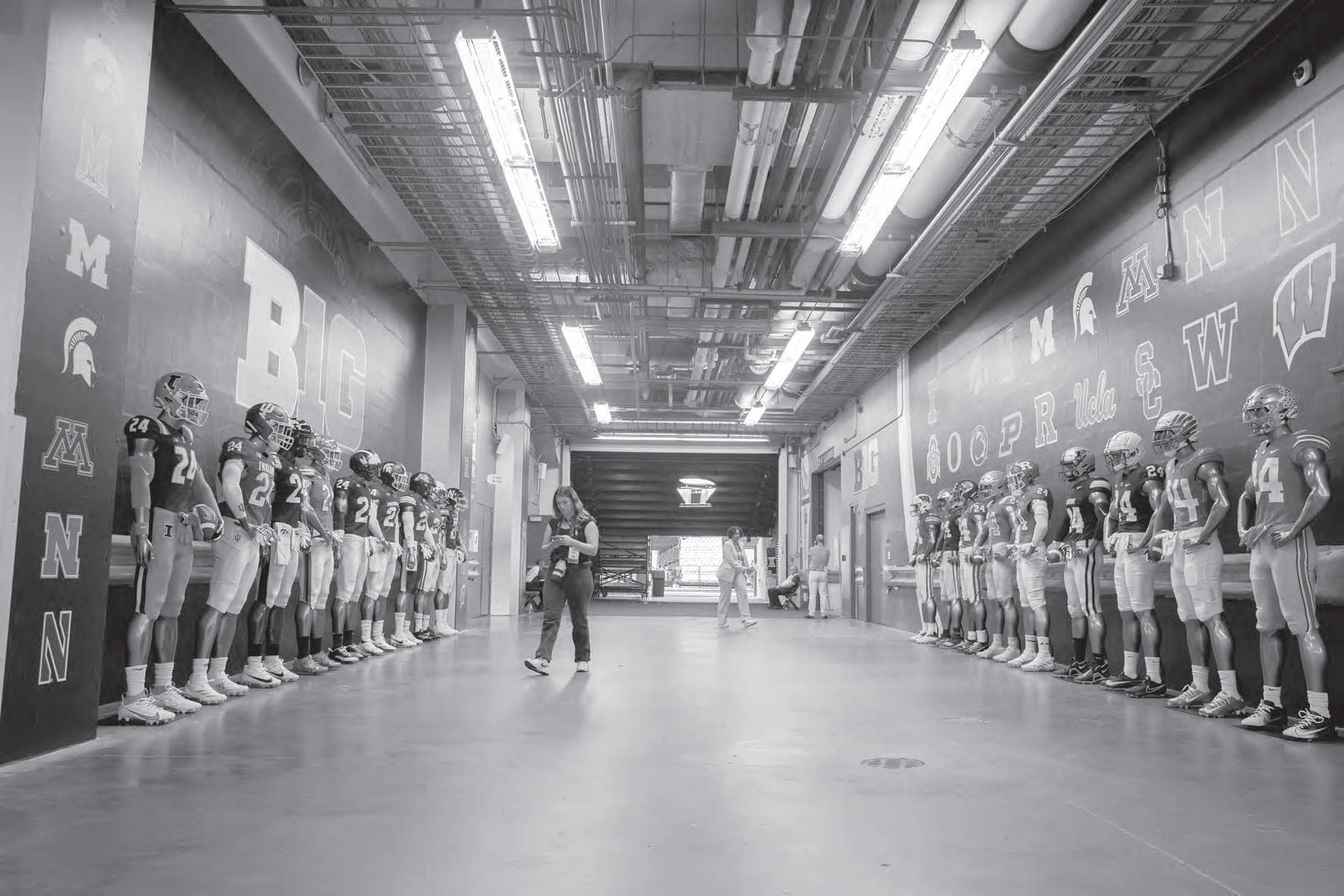
Isabella Tisdale | The Daily Iowan
Big Ten comissioner Tony Pettiti speaks at a press conference during day one of Big Ten Football Media day at Lucas Oil Stadium in Indianapolis, Ind., on July 23. Pettiti recognized Iowa Women’s Basketball for their achievements throughout the season during the press conference.
Isabella Tisdale | The Daily Iowan
Jerseys from all 18 Big Ten schools are displayed in the hallway during day one of Big Ten Football Media day at Lucas Oil Stadium in Indianapolis on July 23. This was the first Big Ten Football Media Day with the now-18 team conference.
Enneking
Dilanni
Iowa fans should attend more away games
The Hawkeyes play in diverse cities, and Iowa fans should visit.

College is about two things:
One of the best ways to gain this experience is by attending away games to cheer on the Hawkeyes.
Every year, Hawkeye athletic teams compete across the country at different campuses, offering students and fans the opportunity to explore new regions.
This year, for example, the football team travels to Los Angeles, Minneapolis, Columbus, and College Park, just outside Washington, D.C. While some of these cities are popular tourist destinations, others are college towns like Iowa City that offer unique experiences.
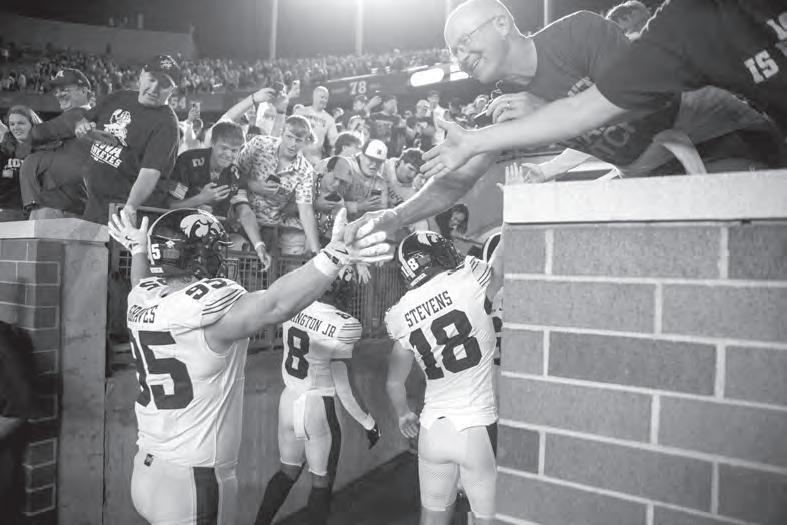
With the addition of UCLA, USC, Washington, and Oregon to the Big Ten, the conference now features a mix of major cities and college towns. Iowa fans can visit cities like Seattle, Los Angeles, New York City, and Washington D.C., as well as college towns like Ann Arbor, Madison, and Eugene.
The Eastern Iowa Airport has flights for three away games, making it easier for fans to attend matchups at Ohio State, Michigan State, and UCLA. These trips give fans a chance to experience both large metropolitan areas and smaller college towns.
The Big Ten is also home to iconic stadiums and arenas. Michigan’s Big House, Nebraska’s Memorial Stadium, Purdue’s Mackey Arena, and UCLA’s Pauley Pavilion, all of which have rich legacies, should be on every sports fan’s bucket list.
Cheering on athletes at away games
COLUMN
Third spaces are on life support
The number of third spaces has been on a downward trend.
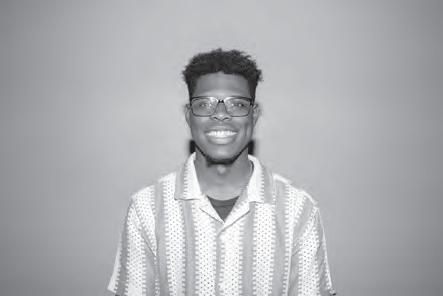
Opinions Columnist opinions@dailyiowan.com
“Water, water everywhere, and not a drop to drink.”
In “The Rime of the Ancient Mariner,” Samuel Taylor Coleridge writes of a mariner who shoots an albatross, setting off a chain of disasters for him and his sailors.
It’s a cautionary tale about being surrounded by what you want yet unable to obtain it. Gen Z faces a similar dilemma, but instead of water, it’s social interactions.
Bank Stadium in Minneapolis on Sept. 21. The Hawkeyes defeated the Golden Gophers 3114, taking back the Floyd of Rosedale Trophy.
can bring a piece of home, even when our teams are thousands of miles away. Fans can help boost team morale and reduce the fatigue our Hawkeye athletes might feel on the road.
While price is a hindrance to attending away games, airlines like United offer student discounts. Traveling with a group is another way to split costs and make the trip more affordable.
Additionally, the university agreed to expand to the West Coast, increasing travel for both student-athletes and fans attending away games. To support these distant games, the university should continue to seek partnerships with local airports and airlines for travel.
Some students may hesitate to travel for fear of seeing the Hawkeyes lose.
While the Hawkeyes losing is a rarity, the experience of visiting a new city or region more than makes up for it.
Traveling as a college student is important. It can give you a firsthand look at cities where you might want to live or work, or it can introduce you to schools you could consider for postgraduate studies.
With new schools joining the Big Ten, our athletic teams travel more than ever. Both major cities and small college towns make up the conference, which offers unique travel opportunities for students and fans. Now is the perfect time to attend more away games.
Suitcase school stifles independence
UI students often make weekend trips back home, leaving their chance at growth growth and development at the door.

Muskan Mehta Opinions Columnist opinions@dailyiowan.com
It’s Friday, and students are flooding the streets and bars, ready to destress after a long week. Yet, countless others are packing their bags and loading them into cars, preparing to head home.
The University of Iowa has often earned a reputation among students as a “suitcase school.” In other words, a significant portion of the student body goes home on the weekends, creating a unique campus dynamic that contrasts with the traditional college experience. Frequent trips home can inadvertently lessen independence. Learning to live alone and not depend on parents is one of the main life lessons of college.
As the largest university in the state, with a relatively low in-state tuition of $11,283, the UI attracts more residents than non-residents. A 2017 geographical profile detailed that most new students came from either Iowa or Illinois, with 19,200 and 6,117 students, respectively. With a total student body of over 32,000 in 2024, the number of Iowa residents at the UI has surely increased.
This proximity to home often leads students, especially freshmen, back to their families. For many, this is their first time living away from the comfort of home. Whether it’s maintaining a schedule, finding food and resources, or coping with homesickness, freshmen often struggle to manage their new responsibilities.
College is traditionally seen as a step toward personal growth and selfsufficiency. Students are encouraged to form new friendships and develop a sense
Jami Martin-Trainor
of autonomy away from parental guidance.
At the UI, new students learn to navigate bus routes, find places to eat, and take care of their dorm or apartment. But for many kids, it’s easy to escape these pressures by taking routine trips home.
First-year Karen Liu graduated from Iowa City West High School, just a fourminute drive from the UI campus. Many of her high school classmates also attend the university, creating a sense of continuity that reinforces the “suitcase” culture.
For some, the ease of a quick trip home might lead to a reluctance to fully engage with campus life, making it easier to avoid challenges that foster growth and resilience.
Resilience is built through experience. Students who confront setbacks — whether academic failures, social rejections, or the difficulties of living alone — often emerge stronger and more self-reliant. While parental emotional support is important,
I can’t tell you how many of my friends have shared the overwhelming sense of isolation they feel. It’s heartbreaking and widespread. A study by Cigna revealed that Gen Z reports the highest level of loneliness in America, with 73 percent of those surveyed saying they almost always feel alone. Enter third spaces. Sociologist Ray Oldenburg coined the term in his 1989 book, “The Great Good Place,” referring to social spaces separate from home and work. These spaces foster interaction, relaxation, equality amongst members, and community building. Think of your favorite place to hang out — maybe it’s Java House or your intramural sports team. For me, it’s Critical Hit Games. These are third spaces.
The problem: They’re dying.
The National Library of Medicine tracked third-space establishments from the Great Recession of 2008 until 2015 and found a decrease in nearly every category. Places for entertainment and recreation dropped by 18 percent, religious organizations fell 17 percent, and hobby retail stores plummeted 27 percent.
If that wasn’t enough for you, look at dating trends. Gen Z dreams of the perfect meetcute — think of “Love Island USA,” the moststreamed original content July 5 to 11 this year. Maybe you imagine meeting someone at a coffee shop or the library, reaching for the same book but touching hands instead. Well, according to Stanford University, you’re 76 percent more likely to find your partner on Tinder than on campus. Thirty-nine percent of couples cite dating apps as their main way of finding each other, while only 20 percent met through friends. In 1995, meeting through friends was the top method of introduction for couples at 33 percent.
People may say the new third space is the internet, but we both know that’s not an adequate substitute. If it were, we wouldn’t be having this conversation. Sure, social media can act as a gateway into finding niche communities, and it acts as a great way to keep in touch with distant friends and family, but it should complement your social life, not replace it.
No wonder Gen Z feels so alone. However, all hope isn’t lost.
I interviewed Jack Brooks, special projects assistant at City Channel 4 and a colleague of mine. Part of his job involves creating promotional material for organizations across Iowa, giving him a unique perspective on third spaces through his constant interactions with them.

Columnists: Muskan Mehta, Kennedy Lein, James McCurtis, Caden Bell, Cole Walker, Carson Hartzog, Darrell Washington, Jackson Mendoza, Abigail Jones, Reese Thompson
Editorial Board: Jami Martin-Trainor, Marandah Mangra-Dutcher, Jack Moore, Stella Shipman, Carson Hartzog, Charlie Hickman COLUMNS, CARTOONS, and
He says today’s social landscape is definitely different than it has been historically but insists that third spaces aren’t dead.
“It may take more effort to look, but once you start it’s easier to keep in touch,” Brooks said. “However, I do recognize that there is more of a tendency to look at virtual relationships as socialization versus having in-person interactions with people.”
Brooks makes a solid point. While it may be harder to find in-person spaces, that doesn’t mean we should settle for social media alone. Iowa City has a vibrant social scene many students may not know about. Events like Oktoberfest, Latin Fest, and the recently added Africa Fest are great ways to get outside and have fun.
Other spaces to delve into your interests, including Daydream Comics, Critical Hit Games, and FilmScene are right around the corner. The university also sports over 600 clubs. The death of third spaces is real, but Iowa City is alive and kicking.
We can support these places by showing up and showing out. Some third spaces have disappeared because we’ve prioritized online interactions over in-person ones, myself included. And how could we not? The world is increasingly digital.
More third spaces are needed, without a doubt. But while killing the albatross sealed the mariner’s fate, the death of third spaces doesn’t have to seal ours.
Emily Nyberg | The Daily Iowan Fans high-five players after a football game between Iowa and Minnesota at Huntington
Abortion ban threatens Iowa health care
States with bans lose OB-GYNs, and experts predict
Roxy Ekberg Politics Editor roxy.ekberg@dailyiowan.com
Annie Galloway, a third-year medical student at the University of Iowa, plans to enter the field of obstetrics and gynecology after she finishes medical school. Despite having studied at Iowa for her entire collegiate career, Galloway said she would prefer to leave the Hawkeye State for residency training.
Galloway hopes to be matched with a residency program in a state without an abortion ban such as Iowa’s. She does not want her medical training to be limited by legislation.
Galloway said many OB-GYNs and family medicine physicians would be disinclined to practice in a state where they can be restricted from providing life-saving interventions, perpetuating Iowa’s lack of providers.
“Many people who train to be an OB-GYN want to practice at the top of their license, they want to be able to execute their training when appropriate,” Galloway said.
Galloway completed her undergraduate degree at Grinnell College and currently serves on the board of directors for the Emma Goldman Clinic, a reproductive health care facility that provides abortion care in Iowa City.
More medical residents are avoiding states with abortion bans, according to a May report from the Association of American Medical College, which revealed that for the second year in a row, students graduating from U.S. medical schools were less likely to apply for residency positions in states with abortion bans or restrictions.
Iowa enacted a near-total abortion ban on July 29, barring all abortions after fetal cardiac activity is detected, which can be as early as six weeks into a pregnancy. The law includes exceptions for the life of the mother, rape, and incest. The law was enacted after a lengthy court battle concluding with the Iowa Supreme Court, allowing the law to go into effect in July after they found no legal basis to block it from being enacted.
Since the U.S. Supreme Court in 2022 overturned the landmark precedent set in Roe v. Wade, which guaranteed federal protections for abortion access, more than a dozen states have restricted abortion access. And with those new laws came reactions from new doctors: The Association of American Medical College Research Institute found the average state saw a 10.1 percent decline in U.S. doctor of medicine senior applicants.
The report showed overall the number of applicants to residencies in states with abortion bans decreased from the previous cycle by 4.2 percent, compared with a 0.6 percent decrease in states where abortion remained legal.
Across the country, obstetricians in red states — including Texas, Oklahoma, and Tennessee — are leaving their practices, and new doctors are avoiding such states due to restrictive abortion laws.
The departures can result in new and worsened maternity care deserts — areas that lack maternity care — and place strain on physicians who remain. Maternity health care is the health care provided to women, their partners, families, and children before, during, and after pregnancy.
With Iowa’s maternal health care deficit worsening, experts worry the abortion ban will exacerbate the state’s already dwindling OB-GYN numbers.
Iowa has among the fewest number of OB-GYNs per capita in the nation. According to a report from March of Dimes, a nonprofit organization that works to improve the health of mothers and babies, one-third of the state’s 99 counties are considered maternity care deserts, meaning they have no OB-GYNs or birthing facilities.
With medical students like Galloway opting to pursue careers in states without abortion bans, experts worry Iowans’ access to maternity care will only worsen and OB-GYN education and training will decline.
OB-GYN education and retention numbers decrease
Maternal health care experts say Iowa’s abortion ban will have long-term impacts on education in the state, potentially reducing the numbers of providers and OB-GYNs.
Francesca Turner, an OB-GYN in Des Moines and co-founder of Iowans for Health Liberty, said the ban will have a chilling effect on OB-GYNs in Iowa. Turner said she and other OB-GYNs will need to stop and question
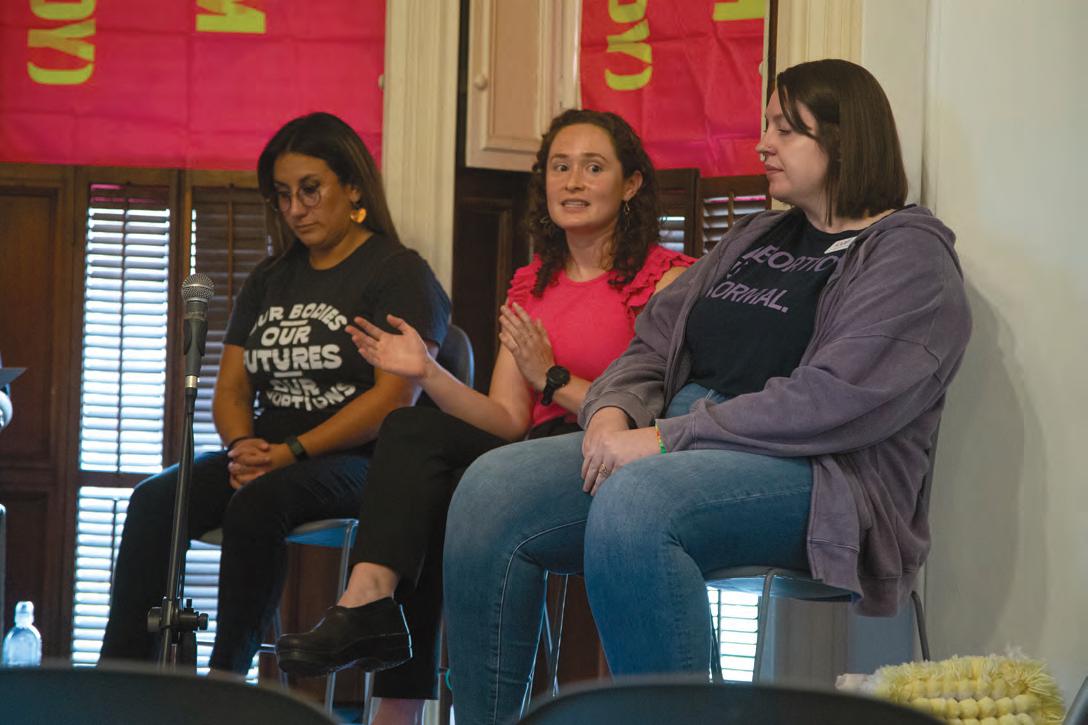
if they are in compliance with the ban.
For those who are the only OB-GYN in their county, if they were to lose their license, every woman in their county loses their provider, Turner said.
The March of Dimes report showed that 90 percent of Iowa’s counties have fewer than three OB-GYNs.
Doctors and providers risk facing up to $10,000 in fines or losing their medical licenses if they break Iowa’s law. The legislation allows women to receive abortion care until there is a “detectable fetal heartbeat,” a term highly disputed among medical groups.
The law includes exceptions for rape and incest, as long as the rape survivors tell police or a health provider within 45 days and incest survivors within 140 days. Another exception is made for when the life of the mother is at risk, but Turner said the language is vague and difficult to interpret.
She said the gray area created by the new law will make her job more stressful and discourage others from entering the field, harming OB-GYN education in the state. Turner is also the American College of Obstetricians and Gynecologists’ legislative chairperson for Iowa.
Turner said the abortion ban threatens education and the accreditation of the UI Health Care OB-GYN residency program because, to meet national accreditation guidelines, a program has to provide full
training in the provision of pregnancy termination, Lehman wrote in the email.
“Like medical schools in states with similar restrictions, the university will adapt to maintain its accreditation and provide the education needed for its students and trainees,” Lehman wrote.
Galloway said medical students are not all able to live out of state or commute to receive training, and they factor in how easily it is to be trained in a state when deciding which residency program they want to match with.
“People are going to want to train where they can learn the full scope of practice of that specialty,” Galloway said. “I think that when states have bans like this, it’s more difficult to get that training, and so I do think that people are going to apply to programs where they know they can get a full scope of training.”
Iowa’s maternal health care deficit worsening
At least 41 Iowa hospitals have closed their labor and delivery services since 2000, according to a 2022 Iowa Department of Public Health report. By 2020, only 46 of Iowa’s 99 counties had at least one hospital providing obstetric services — plummeting from 77 counties in years prior.
The Newton Clinic will halt labor and delivery care later this year, leaving Jasper
“That market has just dried up. I think it’s just a combination combination of [the fact that] they are not getting the training and residency or they don’t have a particular interest in obstetrics.”
Mark Thayer Newton clinic administrator
spectrum training, which includes abortion care.
To receive education on abortion care, residents would have to travel out of state, Turner said, which takes significant planning and could be a financial burden for recently graduated medical students.
According to a statement provided to The Daily Iowan by Josh Lehman, senior communications director for the Iowa Board of Regents, the university will maintain its accreditation and provide education to students and trainees. University of Iowa Health Care officials declined the DI’s request for an interview and directed the DI to the Board of Regents.
The Accreditation Council on Graduate Medical Education currently requires obstetrics and gynecology programs in the United States to include training or access to

County — with a population of about 32,000 people — without an OB-GYN.
The hospital in Newton, Iowa, announced on Aug. 30 that it will no longer continue its hiring process for physicians dedicated to obstetrics for labor and delivery clinics, and as a result, maternal care partner MercyOne Newton Medical Center will pause labor and delivery services indefinitely after Oct. 15.
A March of Dimes report revealed nearly 69,000 Iowan women live in a county without a single obstetric provider.
The decision comes after a decade of significant recruitment struggles, Newton Clinic Administrator Mark Thayer said.
Thayer said 28 years ago, when he was originally hiring doctors, almost all of the applicants wanted to practice obstetrics at the clinic.
“Over the last 10 years, that paradigm has changed, and it’s just a reflection of the reality of how doctors are getting trained nowadays and what their expectations are,” Thayer said.
The clinic has only ever had one OB-GYN, and the last one left in March 2023, Thayer said. For a time, Thayer was receiving quality candidates every three to four months, but that became nonexsistent in the last year, and he has not received an application from a serious candidate in the past 12 months.
“That market has just dried up,” Thayer said. “I think it’s just a combination of [the fact that] they are not getting the training and residency or they don’t have a particular interest in obstetrics.”
The American College of Obstetricians and Gynecologists projects a potential shortfall of up to 22,000 OB-GYN doctors by 2050. Additionally, federal officials projected in a 2021 report from the Department of Health and Human Services that roughly 3,000 fewer OB-GYNs will be practicing in the country by 2030.
The number of medical students applying to OB-GYN residency programs declined by 5.2 percent overall in 2023, according to the American Medical Association. States with abortion bans are experiencing an even ste-
eper decline — a 19 percent drop in Texas and a 21 percent drop in both Alabama and Tennessee. Regarding Iowa’s recent six-week abortion ban, Thayer said it has nothing to do with the OB-GYN recruitment struggles his clinic faces.
“In my 28 years, I’ve never had a doctor ask me to do an elective abortion, not one, so this new legislation has nothing to do with the situation we’ve been dealing with the last 10 years,” Thayer said. “There’s some people that I’ve seen that are trying to use this as a political witch hunt against Governor Reynolds, and the people that were in support of that, and I couldn’t be in any more disagreement. Those people, in my opinion, are uneducated on the topic.”
Nichole Nidey, a UI assistant professor who studies maternal and child health issues, said instead of focusing on whether legislation is conservative or liberal, both parties should identify how to put systems into place that will recruit OB-GYNs to Iowa. Nidey said it’s difficult to predict how OB-GYN closures such as that at the Newton Clinic will impact Iowans, but prior research shows that restricted access to health care is strongly associated with poor outcomes.
“The state really needs to pay attention to how closures are affecting health outcomes for families, because we’re not quite sure what that means for Iowans yet,” Nidey said. Nidey said there is some interest from researchers at the university and elsewhere to study how Iowans will be affected.
Iowa House Democrats and Republicans place abortion and the state’s OB-GYN shortage as a priority for the upcoming legislative session. In past legislation, some Iowa Republicans have tried to define life as beginning at fertilization, known as life-at-conception bills, and enact a total abortion ban, both of which have been unsuccessful.
UI Health Care targets initiatives to close the gap
UI Health Care is pursuing several initiatives to fix the state’s growing loss of obstetric services, including expanding its obstetrical care capability, according to the department. UI Health Care has over 50 locations across Iowa and several locations for OB-GYN services with offices in Iowa City, Cedar Rapids, Coralville, and Davenport.
In fiscal 2023, eight percent of Iowa’s deliveries occurred at UI Health Care, which is a 24 percent increase from fiscal 2019. The labor and delivery unit at UI Health Care was designed to handle about 1,600 births per year since the early 2000s. Nearly 3,000 babies were delivered at the labor and delivery unit last year. Officials anticipate that number will grow by another thousand in the next few years. With the support of a five-year $10 million grant from the federal Health Resources and Services Administration, UI Health Care specialists are aiming to fulfill Iowa’s obstetric needs by bolstering the obstetric skills of hospitals and providers. Through the use of a mobile simulation program, the department is teaching obstetric skills to ER teams and providers and traveling to rural hospitals to teach the American Academy of Family Physicians’ Advanced Life Support in Obstetrics course.
Hoping to practice medicine on the West Coast and avoid educational limitations caused by abortion bans such as Iowa’s, Galloway, the UI medical student, said she is grateful for the training she has received in the state but does not want to limit her future training.
“Looking at Iowa as a whole state and as a politically red state, it’s discouraging,” Galloway said. “I feel bad that the state will potentially continue to suffer because fewer people may want to practice here.”
Ava Neumaier
Ava Neumaier | The Daily Iowan
Jack Moore Managing News Editor jack.moore@dailyiowan.com
Oct. 7 marked a year since Hamas militants invaded Israel, leaving almost 1,200 dead and taking 250 people hostage in an unprecedented attack. Now, a year later, the ripple effects of the ensuing war, destruction, and hatred are being felt around the world — including at the University of Iowa.
Since the attack, over 40,000 Palestinians have died in Gaza. Lebanon’s Health Minister said on Oct. 3 over 2,000 Lebanese people have died, with numbers expected to increase amid Israel’s latest offensive into the region.
ABC News reports 70 percent of schools have been damaged or destroyed in Gaza. Famine overtook much of the strip from December to May, leaving many to starve to death, according to the United Nations. Hospitals were bombed, and the devastation was catastrophic.
In May, the International Criminal Court issued an arrest warrant against Israeli Prime Minister Benjamin Netanyahu for war crimes. Netanyahu has remained unwavering on the country’s warpath despite dozens of calls and negotiations orchestrated by the United States for a ceasefire.
“If we have to stand alone, we will stand alone. If we need to, we will fight with our fingernails. But we have much more than fingernails,” Netanyahu said in a statement on May 9, just days before Israel’s Independence Day.
Despite its calls for a ceasefire, the U.S. has continued to support Israel by sending weapons and aid to the country over the last year.
The war has sparked countless protests across the U.S. In the spring, protesters at Columbia University made headlines after they encamped on campus for two weeks. The protest ended with a group taking over Hamilton Hall and police dispersing the demonstration.
The UI has seen dozens of protests on its own campus. Every Friday since the war began, people have gathered to protest on the UI’s Pentacrest. In December, nine pro-Palestine protesters chained themselves to the doors of Kinnick Stadium, leading to their arrest.
On May 6, protesters attempted to encamp on Hubbard Park. However, the

Protesters stood outside the UI Law School commencement in May and then marched to the Pentacrest. They also spent three consecutive days on the Pentacrest to show solidarity for Palestine.
Over the summer, protesters attended the Iowa Board of Regents meeting in Iowa City, where they called for the UI to divest from Israel.
Several protests have happened at political events — on both sides of the aisle. Over 200 protesters gathered in April to protest U.S. Rep. Mariannette Miller-Meeks,’ R-Iowa, campaign reception with U.S. House Speaker
Jordan said Israel has a right to the land it is on and that Israel is defending itself. She said most pro-Palestinian protesters do not know the full story. She also encouraged free speech, saying many of her group’s signs and chalk drawings have been defaced over the last year.
“It’s absolutely disturbing that there are students like that on our campus that are willing to be so hateful and that are willing to violate First Amendment rights,” Jordan said.
There have been several counter-demonstrations for Israel on campus. On Saturday, almost 100 pro-Palestinian protesters gath-
“This is often posed as a religious conflict between Islam and Judaism, and it really needs to be understood as a geopolitical conflict in which the majority population of one group is Muslim, and the majority population of another group is Jewish.”
Elizabeth Heineman
Co-director of the Jewish Studies Network and UI professor of History
Mike Johnson speaking at the Marriott hotel. Within the last two weeks, protesters gathered in neighboring Solon to protest Christina Bohannan — Miller-Meeks’ political rival.
A common link throughout these protests is the call for defunding Israel for its “genocide” of the Palestinian people.
“For as long as we allow our institutions to not only be complicit but participate in genocide and ethnic cleansing, we will never reach these goals,” Clara Reynen, local pro-Palestinian activist, said at the June Board of Regents meeting. “I am here because we must do better. We must end all partnerships with Israeli universities and companies that profit from the state of Israel.”
Pro-Israel groups on campus have said that people do not fully understand the conflict and should educate themselves. UI student and chair of the Young Americans for Freedom Jasmyn Jordan has set up numerous tabling events and chalking activities in support of Israel.
Young Americans for Freedom is a conservative group on campus that has hosted several conservative speakers, including Matt Walsh and Chloe Cole. On Oct. 7, the organi-
ered on the Pentacrest for International Day of Action for Palestine. About 10 pro-Israel protesters gathered a counter-demonstration on the Pentacrest.
UI student Itai Ben-Shahar led this counter-protest. He said he lived in Israel during the seventh grade, and people do not understand the full nature of the conflict, which is something he hopes more people will spend time doing.
“It’s sad to see all these people who think that they know everything, and they refuse to do their own research,” Ben-Shahar said during the protest. “They’re willfully ignorant, which is the worst.”
Ben-Shahar said as an Israeli person, he has not noticed direct anti-semitism at the UI. He did say that when he gets involved with protests, it has been more likely for him to get into conflict with people about his beliefs.
First-year UI student and pro-Palestine protester Molly McCants said she wished more people would learn about the conflict and the deaths happening in the Middle East.
“I feel like it would be awesome if there was more talk about it because I think a lot of people on campus would support this,” McCants
said. “I want to make sure I’m out here each

All of this conflict across the country has impacted public opinion on the amount of discrimination toward Jewish and Muslim individuals.
A study by the Pew Research Center released in April 2024 reports a rise in adults saying both Jewish people and Muslims face increasing levels of discrimination, with the percentage of Jewish individuals doubling since 2021.
Elizabeth Heineman, co-director of the Jewish Studies Network and UI professor of History, said that while she has not noticed a definite increase in antisemitism at Iowa, she understands how it could be increasing across the country.
She said there are footholds for antisemitism in society, and it has been that way for generations. She said that the Israel-Hamas war is often misinterpreted as a religious war when it is really a geopolitical conflict.
“This is often posed as a religious conflict between Islam and Judaism, and it really needs to be understood as a geopolitical conflict in which the majority population of one group is Muslim, and the majority population of another group is Jewish,” Heineman said. She said people can forget that there is a range of opinions in Israel and Arab states, and people should avoid assuming an entire group of people wants to destroy the other because it can lead to dehumanization and hate.
At the UI, she said the conflict has stoked fears among people.
“It has definitely created among some people, on both sides, some very real fears, and part of this has to do with things that are happening on campus. And part of this has to do with things that people read, either in the mainstream media or social media,” Heineman said.
Despite these fears, Heineman said she has noticed an increase in students wanting to learn about these topics. As an educator, she thinks spreading knowledge is vital.
As for the future, Heineman is stumped on what the future may hold for this conflict. Israel is positioning itself for a wider war in the Middle East, and an end to the fighting is getting farther out of sight.
“I just have very real fears about where this is all going to go, and a lot of people are going to suffer very badly,” Heineman said.
Edited by Will Shortz No. 0904




Isabella Tisdale | The Daily Iowan
Protesters hold up signs displaying past protests in Iowa City for International Day of Action for Palestine by Iowans for Palestine at the Pentacrest in Iowa City on Oct. 5. During the protest, speakers led chants, and told personal stories.
Local pantry breaks ground to meet rising food demand
Evan Watson News Reporter news@dailyiowan.com
As the issue of food insecurity grows, so does the support for families in need in the increasingly interconnected community of North Liberty.
During Oct. 1 ceremony, the North Liberty Community Pantry broke ground to start construction on a new $4 million facility at 350 W Penn St. in North Liberty. The facility, expected to be completed by summer 2025, will be four times as large as the existing facility, currently located at 89 N Jones Blvd.
At the event, Community Pantry Executive Director Ryan Bobst said the new facility will hopefully address an unfortunate increase in food insecurity in the area.
“We’ve unfortunately seen a dramatic increase in the need from our neighbors for food and clothing and connections to other resources,” he said. “Our current space of 2,300 square feet has been woefully inadequate to meet the needs.”
He said the new facility will be over 10,000 square feet, a planned expansion that has been in discussion for seven years. COVID19 pandemic-related financial benefits from the federal government gave the pantry some leeway, but those have been used.
Now, the pantry is serving more families than before, making the construction of a new facility an urgent need, Bobst said. Bobst said by building and supporting this new facility, the pantry aims to reinforce community values and fulfill important needs of North Liberty citizens.
“I believe everyone has the right to be free from hunger, and everyone has the right to be treated with dignity and respect,” he said. “This new facility and the Planting New Roots Campaign helped meet both of those values.”
The Planting New Roots Campaign is the financial campaign dedicated to raising money and support for the new facility and its staff.
The facility is planned to open in the summer of 2025, and work is set to begin Oct. 2. Bobst said the priority is to get the building enclosed soon so work can continue through the winter months.
He said putting the pantry at 350 W Penn St. was a community decision. The food pantry is a place of support for food-insecure residents, but to Bobst, it represents a source of community beyond its pantry services.
“The day that we decided to look for land to build a larger facility, I had about five people tell me we should look at 350 W Penn,” Bobst said. “Exploring it in the neighborhood itself puts us closer to a lot of families we serve in North Liberty and connects to the North Liberty recreational trail.”
He said another exciting element is the Crandick Rail Line Project, which looks to put an unused railway in the area to use. The pantry would potentially be a stop along that line.
Members from various boards and committees dedicated to the Community Pantry were present and took turns breaking ground with large faux silverware. Bobst said that the growing support around the
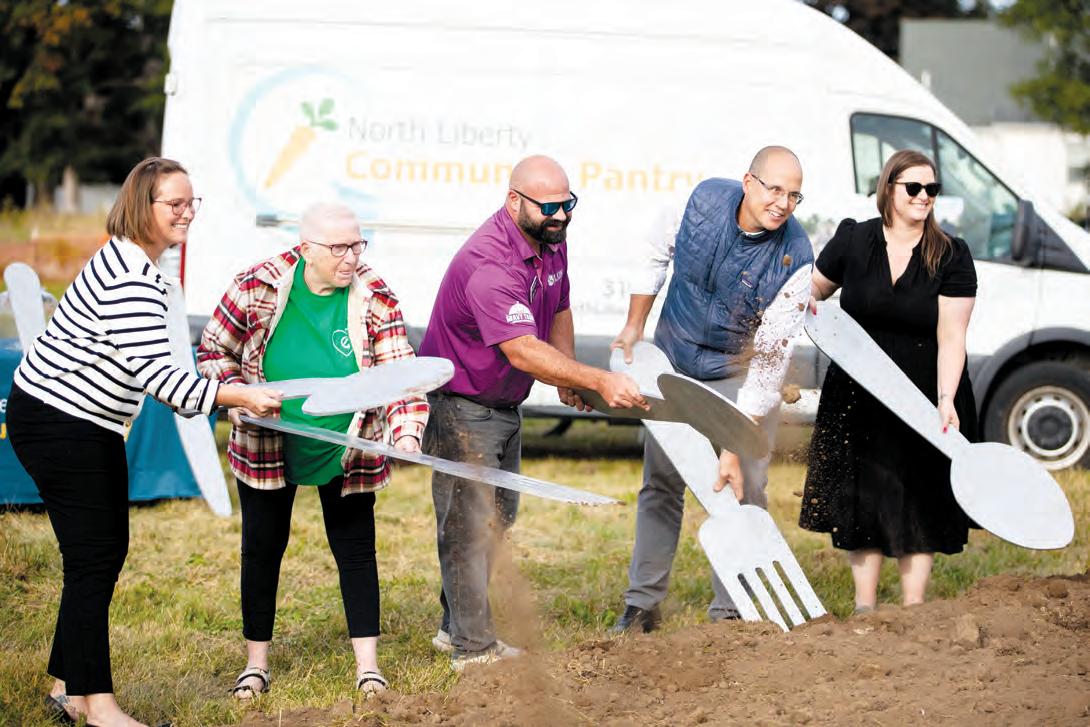
Community Pantry has resulted in its success, especially considering its beginnings as a small closet run by women of a local church in 1985.
“I think it started with a desire to feed neighbors that were hungry. And that core sense has stayed with me,” he said. “As more neighbors develop more need, we continue to grow and to meet that. And that’s what we’re doing today.”
Pantry Board Member Allison Bates said the new facility is important to the community in North Liberty now and in the future.
“This is a big step for the community of North Liberty, moving out on our own and being able to plant these roots,” Bates said. “There is a need in the community that has grown tremendously, and we want to be able to meet that need.”
She said she is happy to see the connections made at the pantry and the support for families who do not know where their next meal is coming from.
Community Pantry Board Chair Micah Ariel James spoke at the event, commemorating the pantry and its supporters for the pantry’s growth and continued success.
“I don’t know if the church members who started a small pantry in a church closet in 1985 could have imagined how the North Liberty Community Pantry grows to support the needs of our neighbors,” James said.
She said the pantry saw a 69 percent increase in families served, a 103 percent increase in food distributions, and a 454
percent increase in clothing distributions between 2021 and 2023. She said in North Liberty, the need for food services and, fortunately, the Community Pantry are growing alongside each other.
“Today, the Board is pleased to break ground on a new facility that will allow us to meet the growing needs of our community and will bring us closer to many of the families the pantry serves,” James said.
LOCATION OF NORTH LIBERTY PANTRY
The new pantry is projected to be around four times larger than the original facility.

The construction would start in 2029 and take three to four years to complete.
Madelyn Ambroz News Reporter news@dailyiowan.com
The Burlington Street Bridge has sparked discussion for a much-needed replacement that could cost the city and Iowa Department of Transportation up to $30 million. Built in 1915, the concrete bridge overlooking the Burlington Dam connects the west side of the University of Iowa’s campus with the east. The last set of major repairs was done in 1989.
Due to its location, the bridge, as well as the pedestrian overpasses, is in almost constant use. Considering its importance in the transportation of Iowa City students and residents, it’s crucial that the bridge stays in proper working condition.
However, an inspection done by the city and reviewed by City Engineer Jason Havel in 2021 found the bridge was in “poor condition” and needed major repairs. Concerns centered around some cracking and exposed reinforced steel along the bridge.
For these reasons the city decided that, with the bridge being a principal roadway
and averaging around 18,900 travelers daily, the project was needed for Iowa City and the construction was approved.
Justin Harland, the Iowa City senior civil engineer, wrote in an email to The Daily Iowan that the project is still in the early stages, but the design was approved to start this month. The actual construction on the bridge is not expected to start until 2029, and the project is anticipated to span over three to four years.
“The existing bridges have reached the end of their useful service life,” Harland wrote.
“Both bridges show signs of deterioration that

require frequent maintenance and monitoring in order to serve the public.”
The call to replace the bridge also issued the need to potentially repair or replace the dam located directly under the bridge.
Harland said that the city will collaborate with the Iowa Department of Transportation as well as the University of Iowa in order to properly replace the bridge.
Iowa City will also work closely with HDR Inc., a company that works widely and specializes in architecture, engineering, environmental, and construction services. The HDR will help provide engineering consultant services throughout the project.
Burlington Street is also the connection for the UI Health Care Stead Family Children’s Hospital and various athletics complexes like Kinnick Stadium and Carver-Hawkeye Arena.
“I take the Burlington bridge every day to classes, the gym, [and] downtown,” first-year UI student Sean Hamilton said.
For students living in the west side dorms including Rienow, Slater, Hillcrest, and Petersen, the Burlington Bridge is a key factor in accessing the rest of campus. And for those living closer to downtown Iowa City, any features on the west side require the bridge’s use to access.
“Majority of my classes are on the west side, so I need the bridge to drive to them,” Olivia Kraus, a second-year pre-nursing major at the UI, said.
Kraus explained that many departments within the university are confined to the west side. As a pre-nursing major, she is tasked with driving from her downtown apartment to the nursing building almost every morning. The estimated cost of the construction was totaled to $30 millon, according to the city in their project application.
According to a report from the city, the project has already received roughly $300,000 from the Bridge Investment Program and is anticipated to receive $1,500,000 from the Iowa DOT.
Harland said they are looking to fund the project through the partnership and local, state, and federal funds. The city was also awarded a Bridge Investment Plan by the Federal Highway Administration for the project design.
Hannah Neuville | The Daily Iowan
Capital Campaign committee members commence the start of the construction of a new building during the groundbreaking event for the organization on Oct. 1. Several groups had the opportunity to use giant forks, spoons, and knives to mark the occasion.
Shaely Odean | The Daily Iowan
The Burlington Street bridge is seen on Sept. 26. The rennovation is expected to cost $30 million.
Map by Emily Pavilk | The Daily Iowan
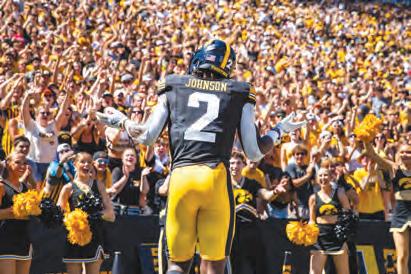
PREGAME: Iowa vs. Washington
New era, same fan base
Iowa women’s basketball retains its loyal fan base despite losing four beloved figures.
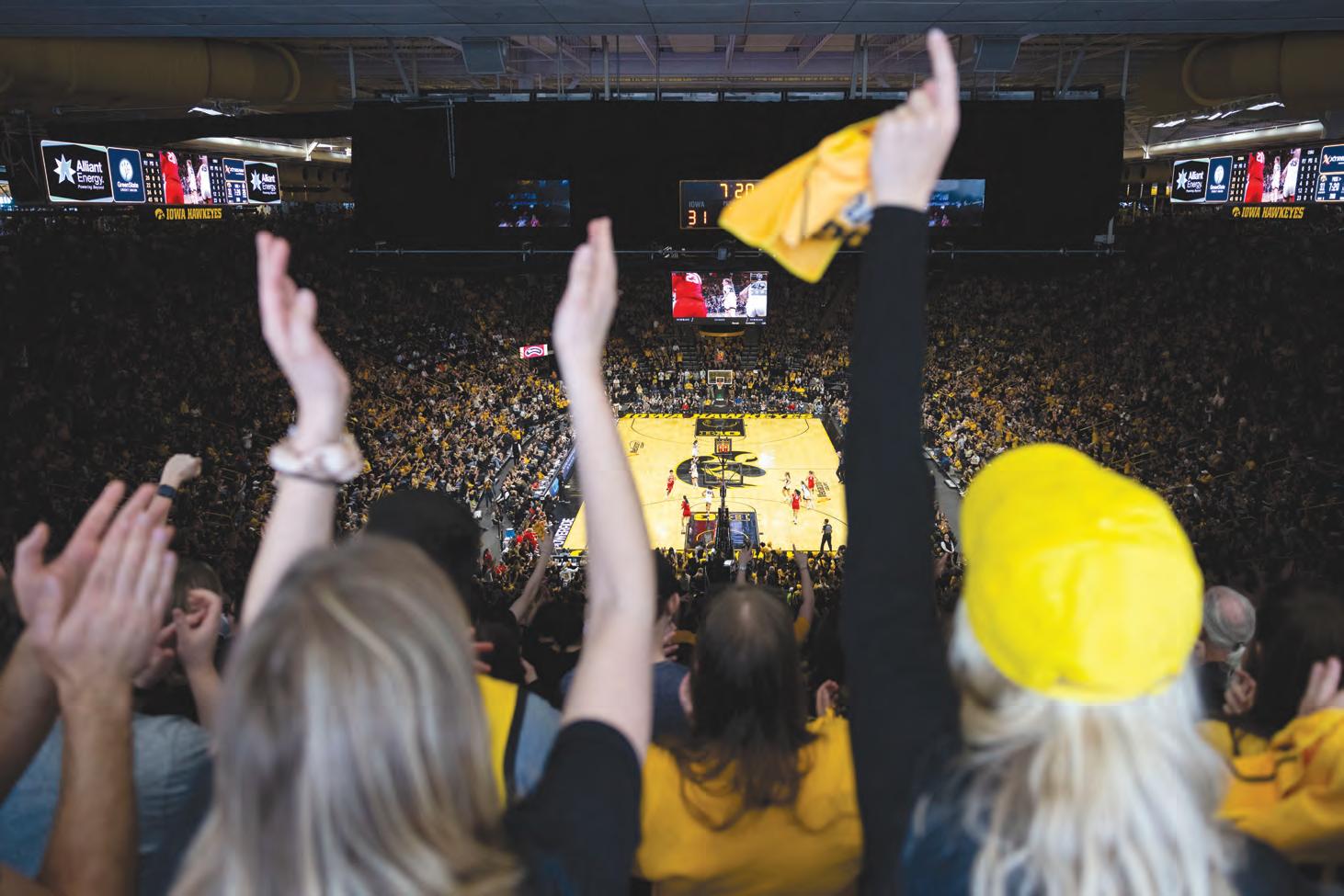
Chris Meglio
Pregame Reporter sports@dailyiowan.com
College basketball is right around the corner, and the hype around the Iowa women’s basketball team is already buzzing.
The wide majority of the women’s college basketball landscape assumed the Hawkeyes wouldn’t see nearly the same amount of attention as they did last year — and rightfully so. Last season was one-of-a-kind. Caitlin Clark, Kate Martin, and Gabbie Marshall as well as head coach Lisa Bluder formed a team that sold out almost every game, broke several viewership records, and for the second time in a row finished as a runner-up in the NCAA tournament to powerhouse South Carolina.
time that I’ve been there before,” fourthyear student Anna Scott said. “Regardless of who’s playing, I think there’s a really good culture around basketball at Iowa, and it’s always felt really supportive of the players, whoever’s on the court. It’s a lot of fun to go every single time.”
adults, $190 for faculty, staff and senior discounts, and $115 for youth Student season tickets are priced at $65 With the one-time purchase, fans can attend any home game they choose without having to buy a single-game ticket, even if they attend every home game for the season.
But without these four faces this time around, Iowa still sold out its season tickets for the second straight season, proving that the last few years will have a lingering effect on the fanbase and the community.
“It’s a really good environment every
The season tickets package is available to all Hawkeye fans, and prices vary: Renewal season tickets are priced at $210 for adults, $175 for faculty, staff and senior discounts, and $100 for youth tickets • New season tickets are priced at $225 for
Embracing the tech in athletics
Iowa women’s soccer’s goalkeepers are using virtual reality to develop their skills this season.
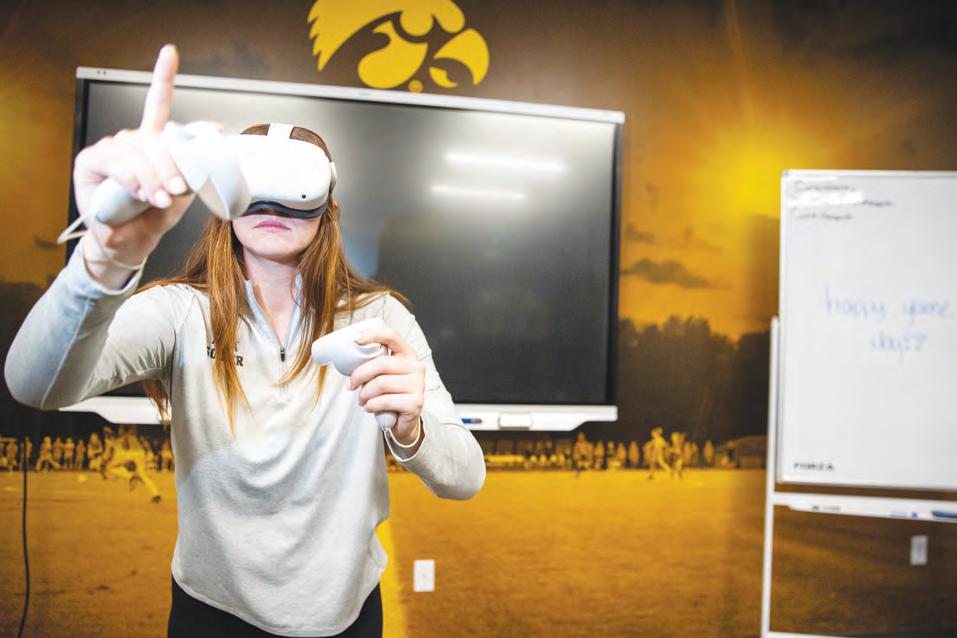
Trey Benson Sports Reporter sports@dailyiowan.com
Off to an impressive 10-0-3 start this season, the No. 7 Iowa women’s soccer team has been using an unorthodox method of training since last spring — virtual reality. Watching goalkeepers Macy Enneking and Taylor Kane compete and fly through the “Reaction Wall,” “Goalkeeper Simulation,” and “Shut-Out” simulations with prowess and ease is truly a sight to witness.
Imagine this: Sitting in a Hawkeye-decorated room with Enneking and Kane physically just a few steps ahead in the real world — and then Meta Quest 2 is put on. Kane and Enneking are transported to a completely different online realm thanks to the use of virtual reality.
The players are transported to a virtual gym-like setting. From punching bags to the heavy rock music in the background, virtual reality truly encapsulates a realworld experience.
Standing in place, Meta Quest controllers in their hands, the Iowa goalkeepers run through exercises that test the quickness of their reactions. They must block shots and click buttons immediately, developing their hand-eye coordination when it comes to in-game decisions on the pitch.
“We use it specifically for reaction times,” Enneking said. “It’s almost like using a reaction board in real life but just through the use of virtual reality. We can look at which hands we use more, our fastest reaction time, our slowest reaction time, and how many hits.”
The lack of physical exertion beyond their reactions is crucial to much-needed rest in between games — all while maintaining progression and developing skills that apply to the position.
“When it comes to just shooting balls or stuff like that, that’s a lot of physical toll, so being able to do it by yourself whenever you want to come in at your convenience is a lot more helpful,” Enneking said. “It’s better than trying to ask a friend to come out and shoot some balls with you because
Megan Chapman, a 27-year-old Iowa City Community School District teacher who had Iowa women’s basketball season tickets for
FIELD HOCKEY
Field Hockey building on momentum
Iowa’s team is looking to ignite its offense going into Big Ten conference play.
Head coach Lisa Cellucci and her Iowa field hockey team have gotten off to a rocky offensive start this season — but are looking to build off of recent momentum moving into Big Ten play.
The Hawkeye offensive unit ranks at the bottom of the Big Ten in production, tied with only Indiana in fewest goals scored. Along with a lack of goal generation, Iowa has struggled to manufacture shots on goal in general, ranking last in the conference in that category with 75.
“We really do have people that can produce upfront,” Cellucci said. “We just haven’t been as connected because they are not used to playing together. Individually, they are very good goal scorers. It’s just us playing together and understanding timing, flow, and finding a way to stay consistently connected.”
Cellucci and her staff have struggled putting together a steady lineup every game. Injuries and an overall youthful roster have caused the coaches to flip-flop a lot of their rotation.
“It really has changed up a lot of the combinations,” Cellucci said. “Now we have a little more consistency in the lineup, so I think that is going to help as well.”
As far as what the team has to do to improve its scoring output, Cellucci says it comes down to taking advantage of opportunities. Cellucci has been pleased with the shots they have generated but needs to see an increase in execution.
“We have to be able to get upgrades and outcomes in our offensive [zone],” Cellucci said. “We are getting lots of entries inside the 25 and inside the circle, but we are just not getting positive outcomes out of it.”
Another factor in the lack of offensive production is the recognition second-year forward Dionne van Aalsum has received. Last year, she established herself as one of the top players in the country after leading all of field hockey in goals scored with 28.
Grace Smith | The Daily Iowan
Iowa celebrates after Iowa guard Caitlin Clark shoots a 3-pointer during a basketball game between then-No. 6 Iowa and then-No. 2 Ohio State inside a sold-out Carver-Hawkeye Arena in Iowa City on March 3. The Hawkeyes upset the Buckeyes, 93-83, on senior night.
Cody Blissett | The Daily Iowan
Iowa goalkeeper Taylor Kane uses a VR headset at the Iowa Soccer Complex in Iowa City on Sept. 30. The VR headsets are used to run through exercises that test the quickness of player reactions.
Football
Saturday, Oct. 12
Washington Iowa City, Iowa
11 a.m.
Soccer
Thursday, Oct. 10
Wisconsin Iowa City, Iowa
7 p.m.
Sunday, Oct. 13
Rutgers Piscataway, New Jersey
1 p.m.
Field Hockey
Friday, Oct. 11
Indiana Iowa City, Iowa
2 p.m.
Sunday, Oct. 13
Monmouth Iowa City, Iowa
12 p.m.
Volleyball
Friday, Oct. 11
Rutgers Coralville, Iowa
6 p.m.
Saturday,
12
Hopes against the Huskies
The Washington Huskies are on a roll after beating Michigan at home.
Colin Votzmeyer Sports Editor colin.votzmeyer@dailyiowan.com
The road doesn’t get any easier as the Iowa football team moves forward this season.
This Saturday welcomes the Washington Huskies, hot off a 27-17 upset win over then-No. 10 Michigan at Husky Stadium on Oct. 5. On the other hand, the Hawkeyes will need to bounce back from their 35-7 collapse to national champion hopeful Ohio State on the same day.
In fact, looking forward is a key theme across the Iowa team after the loss, echoed by head coach Kirk Ferentz in his postgame press conference.
“And that’s what you have to do, win or lose, and that’ll be the key,” he said.
“We’ve still got five games right in front of us and then two more after that … It’s all about what we do on a day-to-day basis, and that’s where our attention will be tomorrow.”
That attention has quickly turned to Washington.
WHAT YOU’VE MISSED
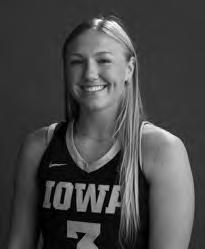
Iowa women’s basketball guard
Sydney Affolter underwent knee surgery and will be out until early November, head coach Jan Jensen said on Oct. 1.
The fourth-year player held a key role in the Hawkeyes’ last season, averaging 8.4 points, 6.4 rebounds, and 2.3 assists across 39 games.
“This is an unfortunate setback for Sydney, but she will work hard during her rehab and is expected to make a full recovery,” Jensen said.
“She has the support of her teammates and coaches, and we look forward to having a healthy Sydney back when she is given clearance from our medical staff.”
Starting the last nine games of the season in place of the injured Molly Davis, Affolter scored at least 10 points in seven of those nine appearances — including a doubledouble of 11 points and 11 rebounds on her way to a Big Ten All-Tournament Team and the Albany 2 All-Regional team.
Affolter is expected to join transfer Lucy Olsen and forward Hannah Stuelke as the three leaders on a new-look Iowa team that has thus far been underrated across the college basketball world. While the injury may pose a difficult setback, Affolter is known for her physicality, toughness, and aggression on the court that will set her up well to succeed in her rehabilitation.
The Hawkeyes kick off the 2024-25 season with an exhibition against Missouri Western on Oct. 30 before the seasonopener against Northern Illinois on Nov. 6 and a highly anticipated rematch with Virginia Tech on Nov. 10.
The Huskies have slightly fallen off from a 14-1 record last season, which culminated in a 34-13 loss to Michigan in the College Football Playoff National Championship. That success brought a major shakeup for the program. With a move to the Big Ten upon the disbanding of the Pac-12, the Huskies are 4-2 with a shaky start to the season.
The Husky offense that pummeled the college football world last year is now missing a wide breadth of its stars to the NFL.
While Heisman contender and quarterback Michael Penix Jr. now spends his rookie year behind Kirk Cousins with the Atlanta Falcons, offensive tackles Troy Fautanu and Roger Rosengarten went east to the Pittsburgh Steelers and
Q&A | LISA CELLUCCI
Baltimore Ravens, respec tively.
Moreover, Penix Jr.’s three wide receiver threats departed with him: Rome Odunze to the Chicago Bears, Ja’Lynn Polk to the New England Patriots, and Jalen McMillan to the Tampa Bay Buccaneers.
Likewise, the defense lost a key piece in outside linebacker Bralen Trice to the Atlanta Falcons as well. And head coach Kalen DeBoer took the job as Al abama’s head coach, suc ceeding legend Nick Saban — and leading it to a No. 1 ranking at its peak.
Now, it’s Jedd Fisch at the helm, coming from the Arizona Wildcats. And the new-look Huskies are still dangerous, as evidenced by their growth over the last two weeks.
After notable 30-9 and 24-5 beatdowns at home over Eastern Michigan and Northwestern, respectively, Washington’s fourth win over the ranked Wolverines adds much momentum and confidence as it enters Week 7.
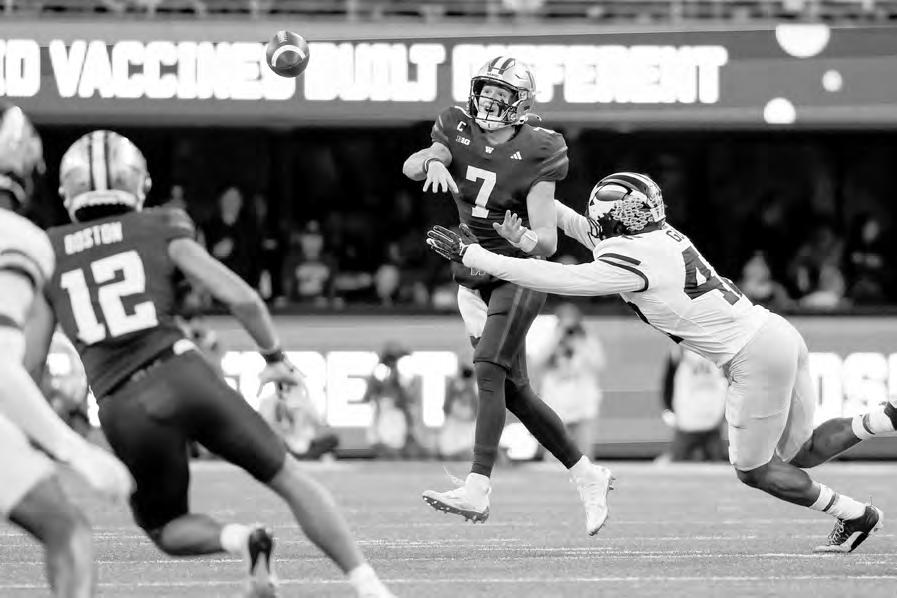
downs against a fortified Michigan defense.
Regardless, the Huskies have struggled in away games — with a 24-19 loss at Washington State and 21-18 loss at Rutgers — and they’ve now got to walk into a rowdy Kinnick Stadium on Saturday for an 11 a.m. kickoff.
Quarterback Will Rogers now leads the Washington offense after a career year at Mississippi State from 2020 to 2023, holding almost every major passing record there as well as the SEC records for single season and career completions.
Indeed, Rogers is a serious problem. The key to winning this game will be pressuring him in and forcing him out of the pocket. That’s because he’s prone to go off, for example 261 yards and four touchdowns in the season opener — and 271 yards and two touch-
While running back Jonah Coleman takes the majority of the rushing reps — and does it well with 11 attempts for 106 gained yards against Eastern Michigan and 16 for 148 against Rutgers — this offense is not at all dependent on rushing touchdowns. Coleman is used more to move the ball, demanding the Iowa defensive line be compact and physical across four quarters to add pressure to Rogers.
As it did last year, the Huskies’ offense instead leans toward an air raid style as five or more receivers can pose a threat. Denzel Boston is clearly the primary target, popping off for six receptions, 125 yards, and two touchdowns at Rutgers, for example.
Still, receivers Jeremiah Hunter and Giles Jackson are each able to break out. And even tight end Decker DeGraaf is targeted in the end zone.
Altogether, the Washington offense is averaging 12.4 yards per catch this
Head coach Lisa Cellucci on 25 years at Iowa
Jake Olson Sports Reporter sports@dailyiowan.com
The Daily Iowan: What is your favorite part about coaching at the University of Iowa? Lisa Cellucci: It is just a real honor and privilege to work at my alma mater because I am a product of this program. [I love] really just being able to give back in a way because this program and university gave so much to me. And [I love] to empower young women.
Do you have any fun postgame traditions you like to do with the team? The team will often give me bribes here or there,

NCAA National Championship losses
Two back-to-back Iowa wom -
QUOTE OF THE WEEK
“Over the long haul, we’re proud of our record. How it all pans out, it’s a year-to-year basis kind of thing.”
Iowa football head coach Kirk Ferentz
STAT OF THE WEEK
yards of total offense allowed to Ohio State on Saturday, a season-worst
season with a total offense average of 462.7. But 45 penalties have cost the Huskies an average of 70.7 yards per game. They can still be restricted by a strong secondary, though, requiring Iowa’s defensive backs to lock in — and demonstrating it’s the Hawkeye defense that will win Iowa this game.
The defense is not quite a walk in the park, but it’s clear the Huskies try to win games by their offense.
Even so, the Washington defense has amassed 13 sacks this season, and the defensive line is the strongest with potential for half a dozen or more tackles for loss and sacks per game.
No single tackler stands out above the others like Iowa linebacker Jay Higgins does. Each is strong as 17 Huskies and has totaled 10 or more tackles this season.
Edge rusher Zach Durfee leads the pass rush, and inside linebacker Alphonzo Tuputala — with 30 total tackles — can blow plays up from across the field.
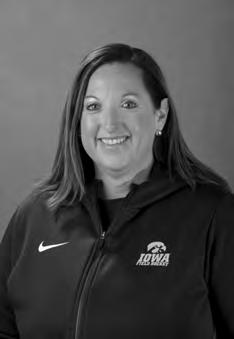
saying, ‘If we score four goals today, can you get us some ice cream?’ Or something like that. Before big games, I will let them give me a little challenge. If I feel like it is OK and appropriate, we will go ahead and execute that. It usually does work, so I am always glad.
What is your favorite sport to go to for Iowa athletics?
I love going to women’s basketball, and I love going to wrestling meets. Wrestling was big in Pennsylvania — that’s where I was from — but I never really went to a wrestling match. Then I came to one of my first ones here as a studentathlete, and it was Iowa versus Iowa State, and I had never seen anything like that.
spend their hard-earned money on tickets and merchandise, and really invest in what’s before them.
It’s taxing, and it’s especially heartbreaking when the first loss ignites a rivalry the sport ing world can’t seem to let go of — even if Clark and Angel Reese have themselves.
en’s basketball NCAA National Championship losses sucked the air out of Iowa City. We all bore witness to Caitlin Clark and the Hawkeyes reshaping the boundaries of women’s collegiate athletics. Indeed, that was unforgettable. And that transcends any piece of hardware Iowa could’ve possibly won.
But the goal at the end of the day is still to win championships. History would’ve been so much sweeter with two rings — or even one. Yet the Hawkeyes came home empty-handed. Twice. And nothing can truly soften that pain.
Cornerback Thaddeus Dixon is his own threat in the secondary, his ability to intercept and break passes making Iowa quarterback Cade McNamara even more careful with the throw. And linebackers Carson Bruener — leading the team with 36 total tackles — and Khmori House have fortified this defense behind the line. Iowa offensive lineman Mason Richman said after last week’s loss to Ohio State that the team needs to “execute at a better rate” moving forward, which will be essential to a win this weekend.
“We’ve got to stop shooting ourselves in the foot,” Richman said. “I think we’ll respond.” With a focused Iowa offensive line — and a conservative and smart throwing game from McNamara — running back Kaleb Johnson should still be able to motor the Hawkeyes to touchdowns and a win. But that includes a constriction of the air raid offense on the other side of the ball too.
Lisa Cellucci Field hockey head coach 25 year tenure
What cool stadiums have you coached on outside of Grant Field?
The University of North Carolina has a beautiful stadium. And Michigan as well. Those are probably my two favorites. And then we have just had some unbelievable battles at Penn State and some really memorable wins for Iowa field hockey there.
What is the most gratifying moment you have had during your Iowa tenure?
Making sure that the players that go through this program understand the women whose backs they are standing on and who have laid the foundation. [We have] to represent all the women that have come before me.

Championship loss
It’s even worse when you do it all again and come up short.
It’s the principle of a national championship. The team dedicates dozens of games and hundreds of hours behind the scenes toward beating out every other program across the country. The fans tune in,
I can’t imagine the pit in the Hawkeyes’ stomachs, but it’s honest to say we all felt something similar when Iowa City — and even the least suspecting of its fans — drudged home in utter exhaustion the second time around. Add in the fact that this team did it all, and it hurts that much more. It ran to the final game of the season after conference championships, all sorts of records, and millions of Americans paying attention throughout — twice. That’s unforgettable, transcending history, but so is losing when it’s all said and done. In any other book, you enjoy the story you just read and move on. Here, the book didn’t quite end. The story was as perfect as it can get, but there will always be a blank page in Iowa athletics history — and it’s this one.
Would you believe me if I told you the Hawkeye football team was 10 minutes away from a College Football Playoff appearance?
While this may seem far-fetched even for the most optimistic Iowa fans, this was nothing but total reality back in 2015.
The 2015 Big Ten Championship was set to be the battle of the ages between field general quarterback Connor Cook of the Michigan State Spartans and C.J. Beathard manning the helm of the powerful Iowa offense.
As we all know, the Spartans ended up defeating the Hawkeyes, 16-13, by scoring a crucial touchdown in the final moments of the fourth quarter.
The heartbreaking loss brought the hopes and dreams that every Iowa alum, student, and future Hawkeye to come has dreamt of at one point or another to a screeching halt.
Beathard threw for over 216 yards this game with one touchdown and one interception. Standout receiver Tevaun Smith led the Hawkeyes in receiving with five receptions while up 110 yards and one touchdown.
Defensively, the Hawkeyes were led by middle linebacker Josey Jewell and cornerback Desmond King. Both Jewell and King continued their talents that they forged at Iowa on to the NFL.
While the 12-team playoff expansion seems to have increased the Hawkeyes’ chances of winning a national title in football, it is still an extremely difficult feat to meet. In fact, the NIL era seems to have made such odds even worse, as money is now the motivation.
One could argue that, with more teams in the playoffs, there’s even more competition, making the race for a national title even harder than years past.
The 16-13 loss to Michigan State marks possibly the last, most realistic chance Hawkeye fans will have of achieving ultimate glory and witnessing Hawkeyes swarm to the National Championship trophy.
However, this was not the case, making this loss to Michigan State the most scarring loss for generations to come. POINT |
Colin Votzmeyer Sports Editor
Trey Benson Sports Reporter
Imagn Images
Affolter
FANBASE from 1B
over a decade, has had a great experience being a season ticket holder throughout the years.
“It’s been tremendous,” Chapman said. “Thinking back to Megan Gustafson, and then having all the other players up until [Caitlin Clark], just to be able to watch Carver go from very few fans … It’s pretty phenomenal.”
Third-year University of Iowa student Robert Rysz went to nearly every home game last season despite not being a season ticket holder. This year, he made sure to guarantee himself a spot at every home game this time around.
“Man, the electric energy at those games is really unlike anything else,” Rysz said. “The football games are flowing loud, but at Carver-Hawkeye Arena, it’s just something else.”
He did have a brief moment when his season ticket aspirations were in jeopardy.
“I logged on right about 9 a.m. [when they went on sale on Oct. 1], and I took the link, and I followed it,” Rysz said. “About, like, 9:01 a.m., by the time I reached the checkout page, it was already gone.
“I was pretty mad, I won’t lie,” he added. “These women’s basketball games, in my two years of being at the university, have been the most fun things to go to. So I was really, really hoping to get these tickets.”
Luckily, he purchased a student season tickets package a couple of days later.
Student season tickets are relatively similar to regular season tickets — gaining access to every home game with a one-time purchase. However, student tickets are only available to UI students for a one-time purchase of $65, and those who purchase the package will guarantee themselves a spot in the student section.
There were no student season tickets last season. Instead, students were able to purchase single-game tickets for the low price of $5.
Scott only went to four games throughout last season as a result and will do the same thing this year.
“It’s mostly a price thing,” Scott said. “If I had the money, I probably would [go to more games]. If I had the time, I probably would go to more games too. I’m pretty busy … I wouldn’t buy them if I couldn’t go to most of them.”
A whole new look
Last year, Clark led the nation in scoring with 31.6 points per game. USC’s Juju Watkins was second with 27.1 points per game, and Villanova guard Lucy Olsen took the third spot with 23.3 points per game.
And after the 2023-24 season, Olsen put her name in the transfer portal. Iowa made a strong recruitment pitch to the star guard, and it was enough for her to commit to Iowa just eight days after the portal entrance.
With Clark’s exit, Olsen brings a new style of dominance for Hawkeye fans to be excited about.
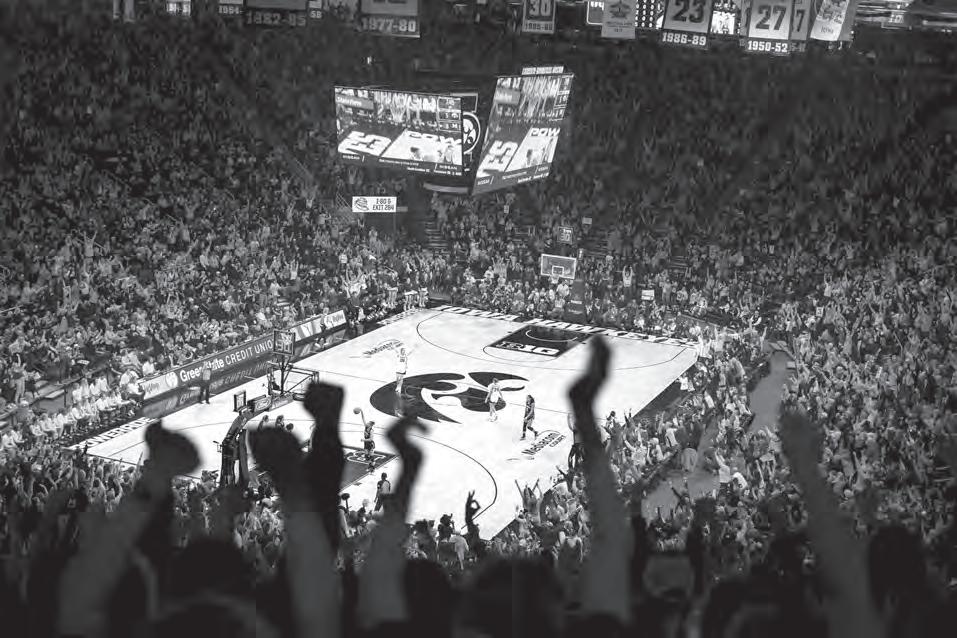
“Even with Caitlin Clark gone … you’re still looking forward to those games,” fourth-year student Max Pesola said. “It might be a little different [with Olsen], but the culture is still there.”
Iowa forward Hannah Stuelke had a breakout 2023-24 season that saw her post averages of 14 points, 6.6 rebounds, and 1.2 assists on 62.7 percent shooting on her way to earning Second Team All-Big Ten honors. The 6-foot-3 center primarily played off of Clark’s passing, whether that was in the pick-and-roll, a low post feed, or a throw-ahead pass.
Scott, who’s seen Stuelke play since high school in the Cedar Rapids area, is most excited to see how the star will take the next jump in her game.
“She’s gotten so much better from year to year since she started playing for Iowa,” Scott said. “I think she’s a really talented player.”
And Hawkeye guard Sydney Affolter, who also made a jump last season, averaging 8.4 points and 6.4 rebounds across 39 games and 12 starts, is expected to make another jump after playing a big role throughout the team’s NCAA tournament run last season.
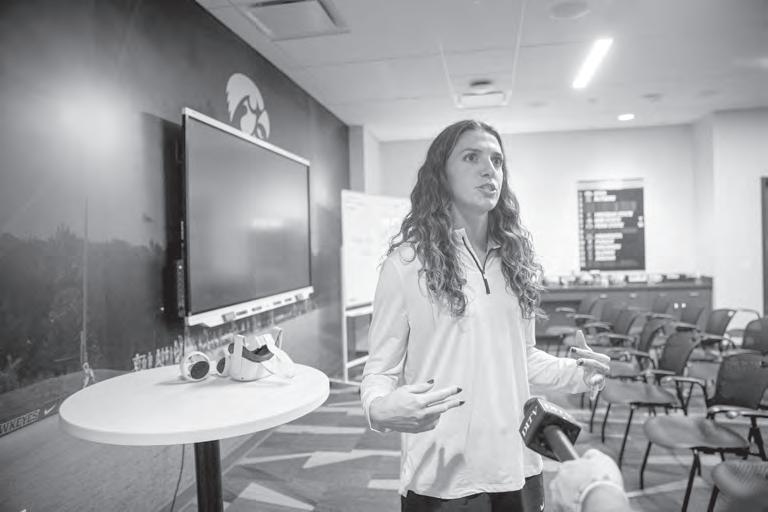
VR from 1B
Unfortunately, the fourth-year guard will be out until early November after undergoing knee surgery. The anticipation is certainly there for when she makes her return to the court.
But in the meantime, who else rises to the occasion will remain to be seen.
“I’m excited to see … who steps up and shoots shots and shows leadership on the court,” Chapman said. “I think [Clark’s] basketball IQ was able to be shared and taught to other girls — to the other young women. And I can’t wait to see who brings what this year.”
So, even with the loss of those who’ve shaped the image of this program and brought everlasting memories to Iowa women’s basketball fans, this new chapter for the program will still hold that same energy, that same excitement, and that same loyalty within Carver-Hawkeye Arena.
“I hate to take the phrase from RAYGUN, but ‘Why not?’” Chapman said. “Why not get in there, be able to see teamwork and positive attitude and just how hard they work and how hard they play? They really are a special group of women.”
University of Iowa usually practice with virtual reality at a minimum of two or three times per week. In season, it’s even used by goalkeepers during pregame.
it also takes a toll on their legs and tiredness.”
Using virtual reality has helped Enneking and Kane both tremendously this season, contributing to the Hawkeyes’ 4-0-1 conference record and first place standing in Big Ten play.
“It’s super helpful for the other side of the game,” Enneking said. “I know [Kane] has emphasized a lot that goalkeeping is a lot of physicality while the other side is the mental side. I think virtual reality helps bring both of those topics together. Since we are not doing as much physically, it’s a lot easier to use and a lot more fun.”
Regardless of initial perceptions and misconceptions of virtual reality, watching this exciting new technology for the first time in person proves there are legitimate benefits.
During the off-season, goalkeepers at the
MOMENTUM from 1B
This season hasn’t been as easy.
Teams have identified van Aalsum’s abilities and have made specific game plans for the talented forward, sometimes throwing multiple defenders her way in an effort to take the ball out of her possession.
Van Aalsum has mustered just four goals this season. But, despite the decrease in production, Cellucci hasn’t seen any change in the way she carries herself on the field.
“Her confidence hasn’t wavered,” Cellucci said. “I think she is pressing a little bit because she wants to score goals — that’s part of her. But for us and for her, we are just continually trying to pump her up. Just keep playing your game and keep getting shots off. When you are really feeling pressure, you have to dish, and then you support and join
and get the ball again.”
An increase in execution will certainly strengthen this No. 13 Iowa team, especially as the defense is as strong as ever. Greater offensive pressure takes the weight off of the back side of the team.
Still, the team has shown flashes of what the unit can do when clicking on that side of the field. The past two away games are prime examples of what the offense is capable of.
Iowa’s latest road trip saw the team taking on Rutgers and Villanova. In these contests, the Hawkeyes showed glimpses of what the offense can be.
The team scored two goals in each game, with every goal coming from a different scorer.
“We can do it,” Cellucci said. “Against Rutgers — our back was against the wall — and we had to score some goals in really timely moments. They received some confidence from that, knowing we have the skills to do this.”
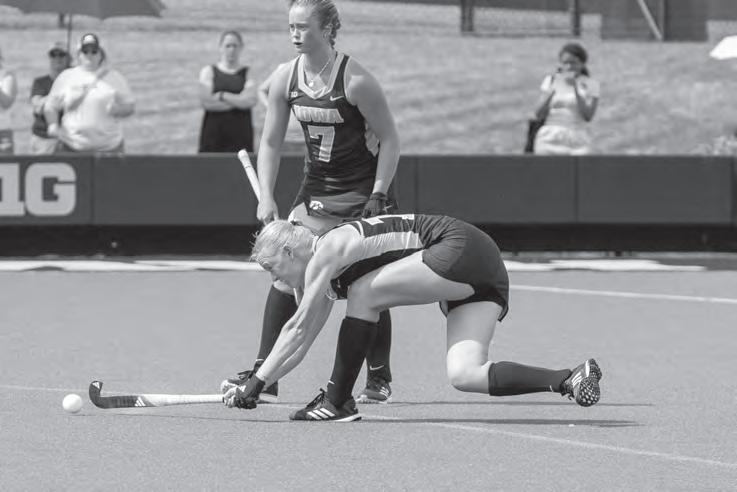



The use of virtual reality has even sparked some friendly competition in what Enneking has coined as the “Goalkeepers Union.”
“We would see who can beat each other today or tomorrow,” she said. “So, I think that [virtual reality] has helped us see growth.”
The Iowa goalkeepers are currently tied for 12th in the country for goal-against average and have a save percentage of .833.
While virtual reality has been predominantly used by the goalkeepers at Iowa, Kane believes there is use for this type of technology beyond the pitch.
“I think goalkeepers across a lot of sports would benefit,” she said. “Hockey, lacrosse — stuff like that. I think it would be interesting to see how tennis would do with it because it is a lot of hand-eye coordination.”


Talan Nelson | The Daily Iowan
Iowa midfielder Dionne van Aalsum sends a shot during a field hockey match between Iowa and Delaware at Grant Field on Sept. 15. The Hawkeyes defeated the Blue Hens, 1-0.
Cody Blissett | The Daily Iowan
Iowa goalkeeper Macy Enneking answers questions during an interview at the Iowa Soccer Complex in Iowa City on Sept. 30. Enneking uses virtual reality to help develop her skills.
Isabella Tisdale | The Daily Iowan
The crowd cheers as Caitlin Clark scores a three-point basket to make her the NCAA record holder for points during a basketball game between then No. 4 Iowa and Michigan at Carver Hawkeye Arena on Feb. 15. The Hawkeyes defeated the Wolverines, 89-106.
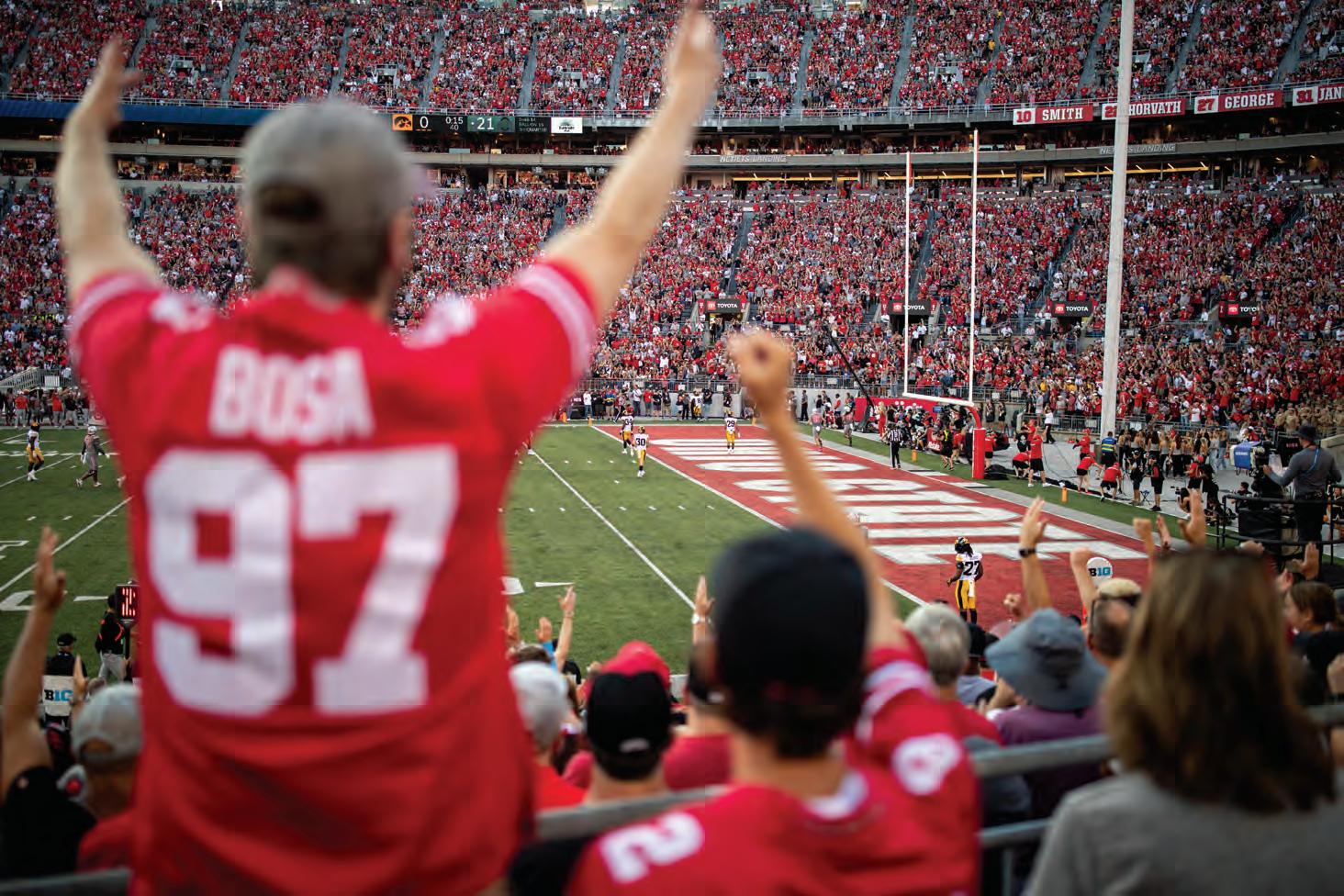

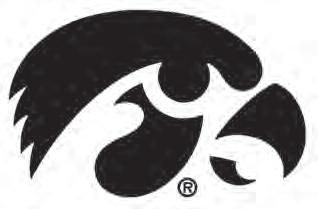
DROPPING THE BALL
Ohio State doubled Iowa in total yards and first downs, leading to an expected loss.
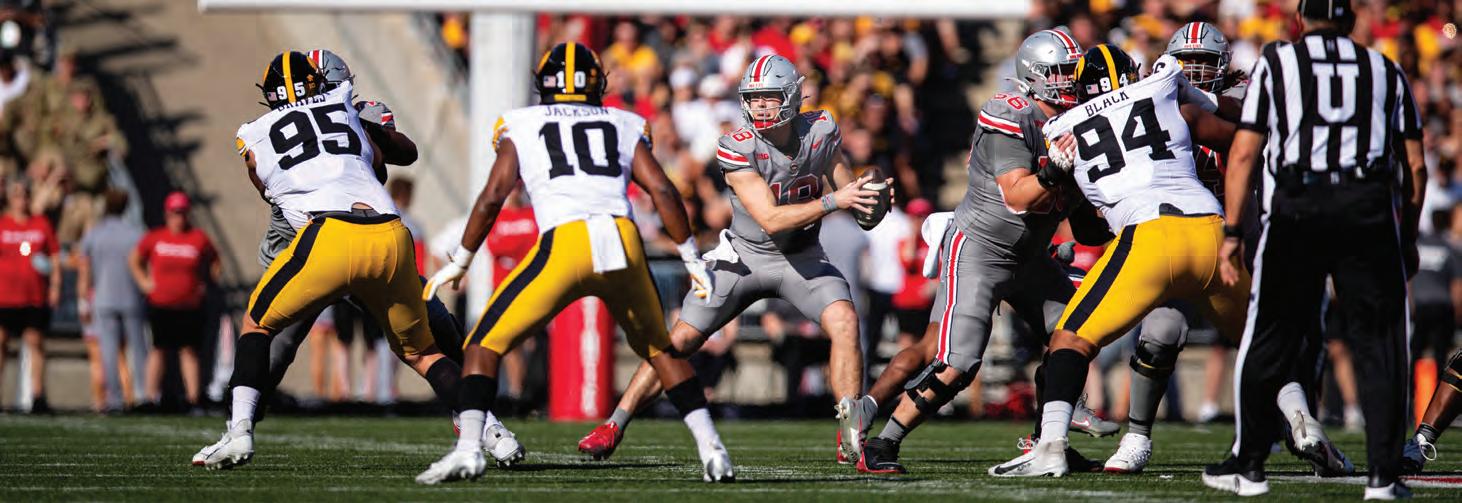
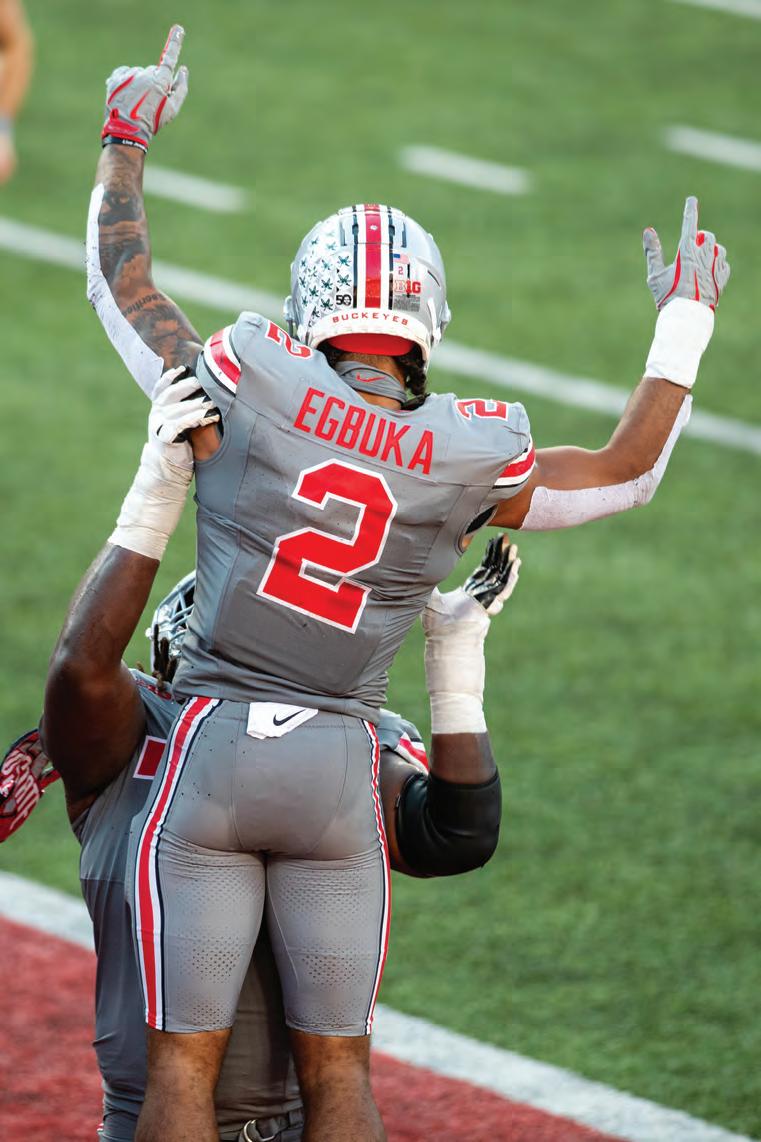
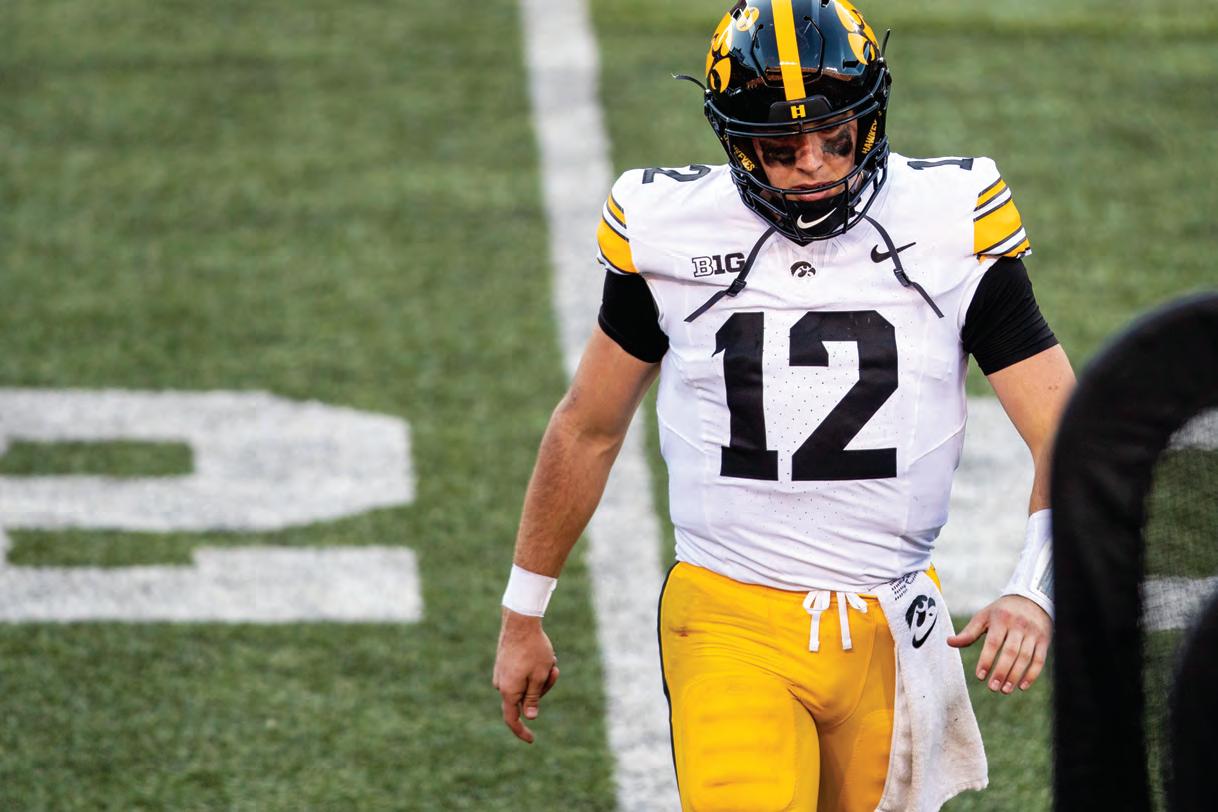

college football is the big one,” Adams said.
College Football 25 is the first college football game since 2013, so the turnout of fans at the Kinnick event reflected the general anticipation for the game. It’s the highest grossing video game of 2024, selling 5 million copies within its first month in the market.
The gaming audience has skyrocketed in size, as the sales reflect. With this large number of fans though, comes an increase in the community’s efforts to give back.
the event, said the organizaion took inspiration from the UI’s proud football culture when choosing the tournament’s game — EA Sports College Football 25.
“We’ve never [hosted events] here in Iowa, so we thought, what unique thing can we bring to Iowa? And
“Gamers are just so generous,” Adams said. “You see some of these personalities on Twitch and YouTube, and they just care so much. They’re the most, dedicated, fired up, energetic people, and they just want to help local kids, just like the rest of us do.”
HBO’s ‘Industry’ season three delivers
The drama set in the world of finance garnered massive popularity.
Charlie Hickman Arts Editor charlie.hickman@dailyiowan.com
HBO is well-regarded for consistently producing compelling TV shows, and “Industry” may end up going down in history as one of the studio’s best.
“Industry” follows a trio of young people as they navigate the complexities of London’s finance scene. From copious amounts of cocaine to regrettable sex and anxiety-inducing client meetings, “Industry” began as a relatively smallscale workplace character drama.

Beginning in 2020, the show has since grown in viewership and is now one of HBO’s flagship titles, airing unobstructed by any other programming this season. The network’s confidence in the show paid off as the third season became the most watched by a mile.
“Industry” is a perfect example of letting shows grow naturally. Rather than canceling it after one season — looking at you, Netflix — HBO gave the series room to grow.
A major factor in this is that most of the talent behind the show was brand new to the business.
Showrunners Mickey Down and Konrad Kay worked in finance before launching “Industry,” and all three of the leads, Myha’la Herrold, Marisa Abela, and Harry Lawtey had little to no experience acting. The show has developed alongside its cast and is now firing on all cylinders to deliver one of the best seasons of TV I’ve seen.
At only eight episodes, I was stunned each week by how much story the showrunners were able to wring out of 50-minute episodes. A good TV show develops drastically between seasons, with status quo changes that feel impactful and lead you to question how characters will possibly react.
“Industry” does this twice an episode in season three.
The scope has ballooned from the walls of the stock v trading floor to
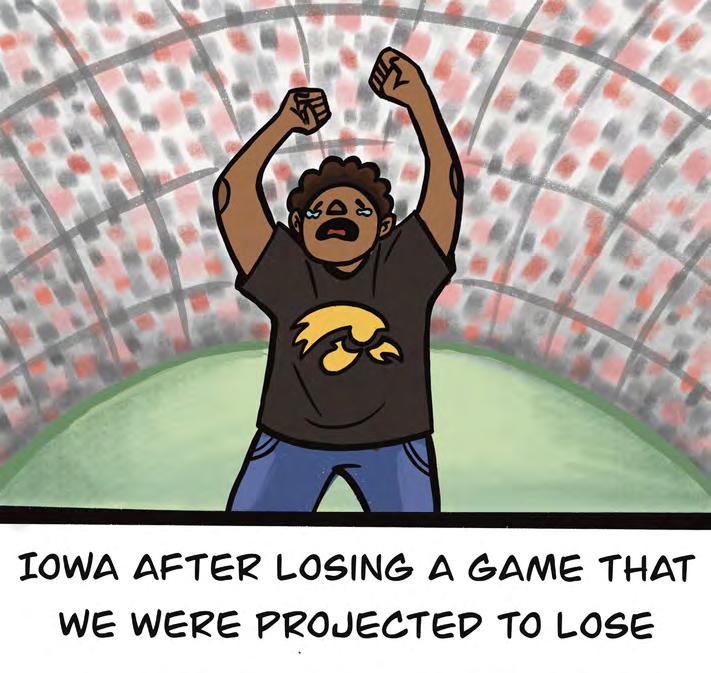
Bus stop mosaics brighten Iowa City neighborhoods
This art project celebrated the city’s fifth annual Climate Fest.
Isabelle Lubguban Arts Reporter arts@dailyiowan.com
In collaboration with the fifth annual Iowa City Climate Fest, art installations made the city’s most popular form of public transportation pop. Several bus shelters got eye-catching makeovers throughout September to highlight the fun side of taking action to protect our environment.
The concept was created a few years ago by the Climate Action and Outreach Division of the Iowa City Downtown District.
“Last year, it was a little bit different. Instead of being neighborhood-focused, we did have a couple of the busiest bus stops around businesses,” Climate Action Engagement Specialist Megan Hill said. “This year, we decided to try something new and engage with community members and a few neighborhood associations to not only get volunteers to create their decorations but to put them up.”
Out of the many bus stops around the Iowa City area, four were decorated. These included the one on Muscatine Avenue and Court Street; the East Court Street and Court Hill Park entrance; Lakeside Drive and Nevada Avenue; and North Van Buren and East Jefferson Street.
Themes ranged from oceanic to floral decorations. When asked about how these four were chosen, Hill explained the research behind her and the team’s decision.
“First, we looked at the locations. We knew that we wanted to have bus stops with the neighborhoods so that if the [neighborhood] associations or [residents] wanted to help decorate, they were able to because it [would be] within walking distance. The second thing we looked at was the bus stops that were the busiest, had the most ridership or a lot of people driving,” Hill said.
Once each stop was set in stone, some Iowa City locals started to generate design ideas. For a larger project
like this, there were many individuals involved in the art process.
Erica Danner, a local painter and tattoo artist with an extensive repertoire, was one of the included artists. After working with the Climate Division for two years, Danner was contacted again so that she could recreate her mosaic style.
Danner also collaborated with several neighborhood associations around Iowa City, showing the spirit of community through art.
“I really like to lean into what’s unique about a project and the space surrounding it, and think about what opportunities there are to do something special that can’t be done with other projects,” Danner said.
Diane Platte, a member of the Longfellow Neighborhood Association, was more than happy with the partnership. The group had previously met up with Danner to exercise their creativity.
In the meeting, everyone worked with stencils and guides for the bus shelter designs at the Robert A. Lee Rec Center. Then, Platte’s association collaborated with the Morningside-Glendale Neighborhood Association to bring the design to life.
“Art is a good way to highlight the environmental benefits of riding the bus,” Ashley Laux, a member of the MorningsideGlendale Neighborhood association, said.
the pristine galas of the British parliament and beyond. “Industry” is a show about its characters first and foremost, so it makes sense that as the characters grow and their careers change, the show would grow with them.
One of the most remarkable plotlines in season three follows Eric, played by Ken Leung. Eric was an authority figure when he was introduced in season one. He’s often shown swinging a baseball bat on the trade floor and mentoring the main characters, but in season three he becomes one of the kids.
Despite its setting, I like to refer to “Industry” as a coming-of-age story since it follows young people finding their place in the world, which is the core of the story. Even though Eric is in his fifties, he goes through the same trials and tribulations of identity and purpose that the kids go through, and it’s riveting to watch.
In my favorite plotline, audiences find Robert Spearing, played by Lawtey, alongside Henry Muck, played by Kit Harrington, a narcissistic Silicon Valley-type CEO in charge of a renewable energy company. Rob is set up by Pierpoint, the bank all the characters work for, to handle the launch of Muck’s company as a publicly traded stock. However, Pierpoint knows the company will fail and is using Rob as a scapegoat for when the catastrophic launch inevitably leads to the bank begging for a cash injection from the British government.
Rob goes through a lot this season, but his incredible turn of luck in the final few episodes is incredibly cathartic and sets up a fascinating arc for season four. In fact, every piece of setup for the next season is handled remarkably well.
The finale of season three feels conclusive, as if the show could’ve ended then and there. Without spoiling anything, this has always felt like the show’s vibe — writing themselves into a corner only to come back stronger the following season.
“Industry” has always been a show about class and the corruption of wealth, but season three steers into crime and politics with ease. The show seems to be heading into more life-and-death situations, with several of the more crime-thriller plotlines coming to a head in the final moments. Whatever season four has in store, I will be on the edge of my seat waiting to return to the cocaine-fueled chaos of “Industry.”
Truman Capote Award recipient
Haya Hussain Arts Reporter arts@dailyiowan.com
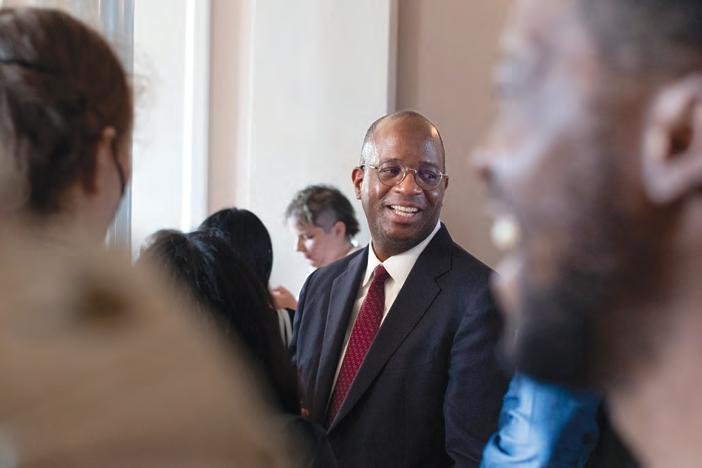
In November 2022, writer, educator, and scholar Gene Jarrett’s biographical novel “Paul Laurence Dunbar: The Life and Times of a Caged Bird” finally hit book stands after 15 years of deliberate hard work. Now, the novel is recognized by the University of Iowa’s Truman Capote Award for Literary Criticism. Jarrett spoke to The Daily Iowan before his award ceremony to explain his writing process.
Jarrett is currently the dean of faculty and a professor at Princeton University.
The Daily Iowan : How is this award different from past accommodations?
Jarrett: This one is special because it is recognition for something that I have worked on for a long time. It gratifies me that my colleagues appreciate this work, and I’m grateful it’s having an impact. My colleagues who won this award previously are highly decorated, so it’s special for me to be a part of this legacy of excellence.
Can you share more about where this book started?
I worked on a junior paper focused on Paul Laurence Dunbar in college. He was a poet of the late 19th century, born and raised in Dayton, Ohio. He had descended from Kentucky slaves, and he went on to have an international reputation. He had a fascinating life and was an excellent writer, and I wanted to learn more about him.
writing process look like for this project?
I’ve worked on this book for over a decade and a half. First of all, it required a deep understanding of Dunbar’s writings and everything written about him. Then I had to examine his letters of correspondence. He was writing letters to people. People were writing letters to him, and different parties were writing letters to each other about him, and so doing the research in the archives to find all these letters, to paint the discourse that surrounded his name and his life and his literature, that discourse had to be illustrated.
The elements of writing the work required much time, and then there’s the rewriting of it, right? 10 years in I would look at what I wrote in the early parts of the first chapter, and I thought, “Well, this could have been improved.” I always had to be open to strengthening my writing as much as possible.
If you think about your life, who you were 14 years ago is different from where you are today. There were multiple presidential elections, my children were being born, and I was moving houses and changing jobs. Writing any kind of book that takes sustained attention requires you to be focused and stable.



Pixels directed by Chris Columbus
MAGGIE’S PIZZA
This dedication was on full display at Kinnick as gamers picked up their controllers to begin the tournament. Participants had to raise a minimum of $200 to qualify for the single-elimination, bracket-style event.
The event began at 10 a.m., and the stadium was alive with nervous energy as 64 determined gamers gripped their controllers, white-knuckled in anticipation for the first round to begin.
Throughout the six rounds of competition, Herky the Hawk flitted through the crowd, cheering participants on and riling up the spectators. Iowa football players Leshon Williams, Jacob Gill, and Brendan Sullivan also made appearances, waving and mingling with the crowd.
Participant Micah Garringer is a frequent esports competitor and traveled from Marshalltown, Iowa to compete. Although he was eliminated in the morning rounds, his team raised $450, keeping him in good spirits.
“We had some real stuff competition this morning, but I’m not worried about it. I’m really just here to have a good time and learn some stuff,” said Garringer.
For other participants, this tournament was more than just a competition — it was a way to support a cause that hits close to home. Cole Corson shared that his family uses the Stead Family Children’s Hospital.
“My daughter has had stuff done at the Children’s Hospital, and so I thought it was a great fit for me to support something that I have first-hand experience with,” Corson said.
As the sun dipped lower in the sky, the fierce competitors were gradually eliminated, relinquishing their controllers and joining the throng of eager spectators. By mid-afternoon, only two skilled gamers were left: Brandon Capper and Herve Cantrell. The air crackled with anticipation as they took their seats for the final showdown, which was broadcasted live on Hawk Vision.
“We had some real stuff competition this morning, but I’m not worried about it. I’m really just here to have a good time and learn some stuff.”
Micah Garringer Event Participant
Though Capper and Cantrell fiercely battled for every pixelated pass and perfectly timed tackle, the crowd went wild as Cantrell ultimately seized the win, securing his place as champion.
The Extra Life Charity challenge is one of many events around the county where gamers are stepping up for a good cause, but the gaming community’s impact is even more amplified online.
Livestreaming platforms like Twitch and Kick have
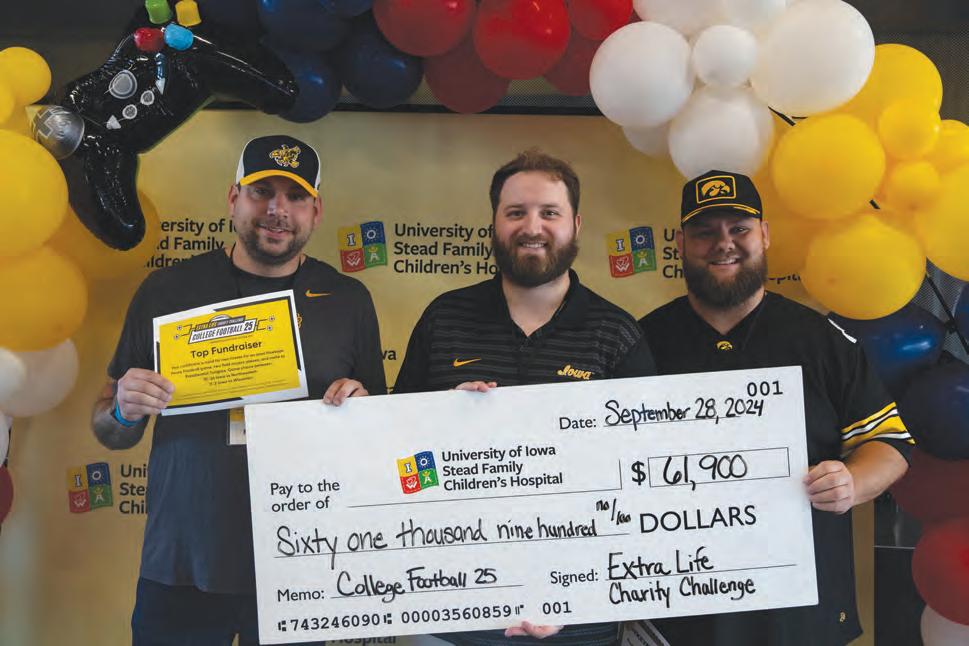
helped facilitate global connectivity in the gaming community by allowing millions of people to congregate virtually and participate in one shared gaming experience.
Influencers in the gaming world and on social media have been quick to use this for a good cause, fundraising by soliciting donations as they stream.
Their fundraising methods range from wildly unconventional — such as popular gaming streamer Ludwig Ahgren, who spent 50 hours locked in a small glass box to raise money for the Alveus Sanctuary — to more traditional, like streaming themselves gaming or chatting with viewers.
Either way, these efforts can be largely successful, with popular streams raising hundreds of thousands of dollars in minutes.
Ahgren’s glass box stream raised $315,000, half of which he donated. Last October, popular Twitch streamer Hasan Piker raised over $1 million for humanitarian aid to Palestine, with $180,000 raised in the first 40 minutes of his stream.
“It’s really cool,” Adams said. “They take what they’re really good at, which is their gaming, their content creation, whatever it is, and they use it for an avenue to do some good.”
Twitch has encouraged these charitable efforts by
establishing tools within its platform to help creators raise money effectively and transparently and to help viewers donate quickly and with ease.
Gaming charity streams have influenced broader philanthropic endeavors within the video game industry. Riot Games, a major developer of hits like those of “Valorant” and “League of Legends”. Their games are the source of millions of dollars in revenue from esports events.
Thanks to the popularity of charity streams on gaming platforms, Riot Games established a Social Impact Fund that supports nonprofits around the world.
Whether online or in-person, players globally are redefining what philanthropy and activism looks like by challenging traditional fundraising models and making charity more accessible and engaging for younger generations.
“I had donated to local GoFundMe [pages] and things like that in the past, but I watched [Hasan’s] stream and so did a lot of my friends,” 22-year-old UI student Lauren Bredeson, said. “I think that it was one of the first times that I saw people in my generation widely, fiscally contributing to charities, rather than just, like, reposting links and I thought that that was really sweet.”

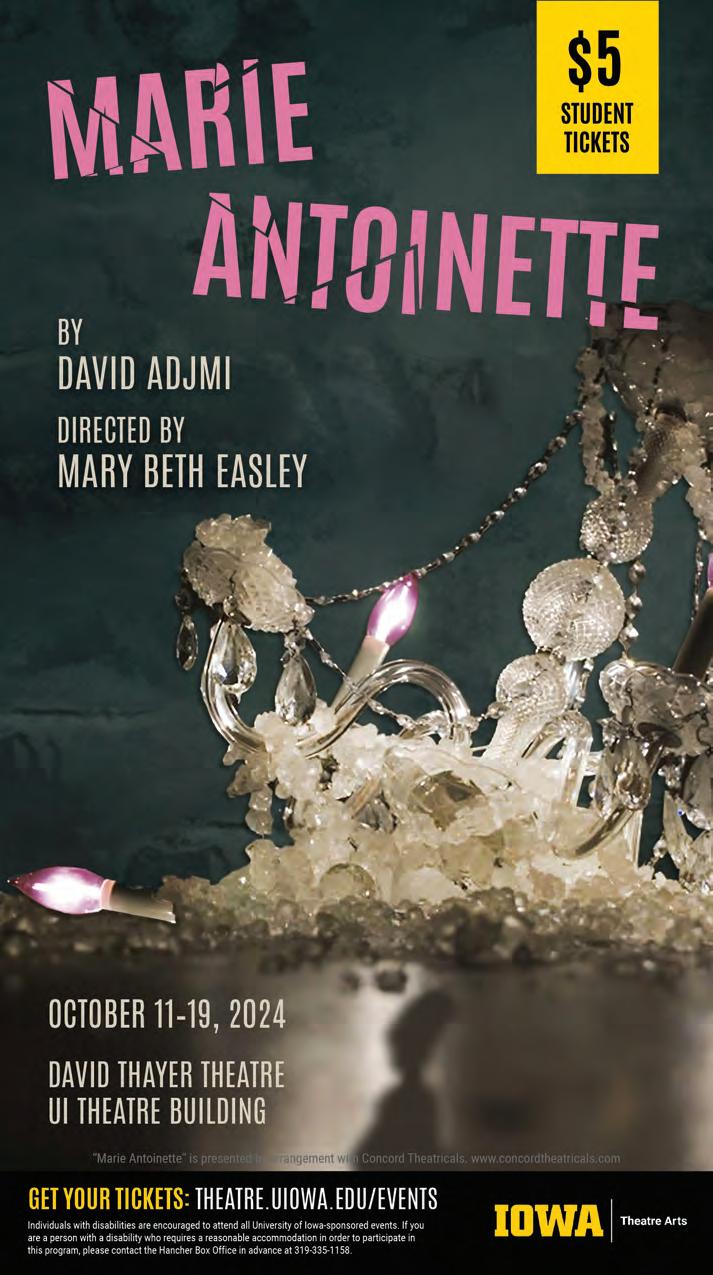
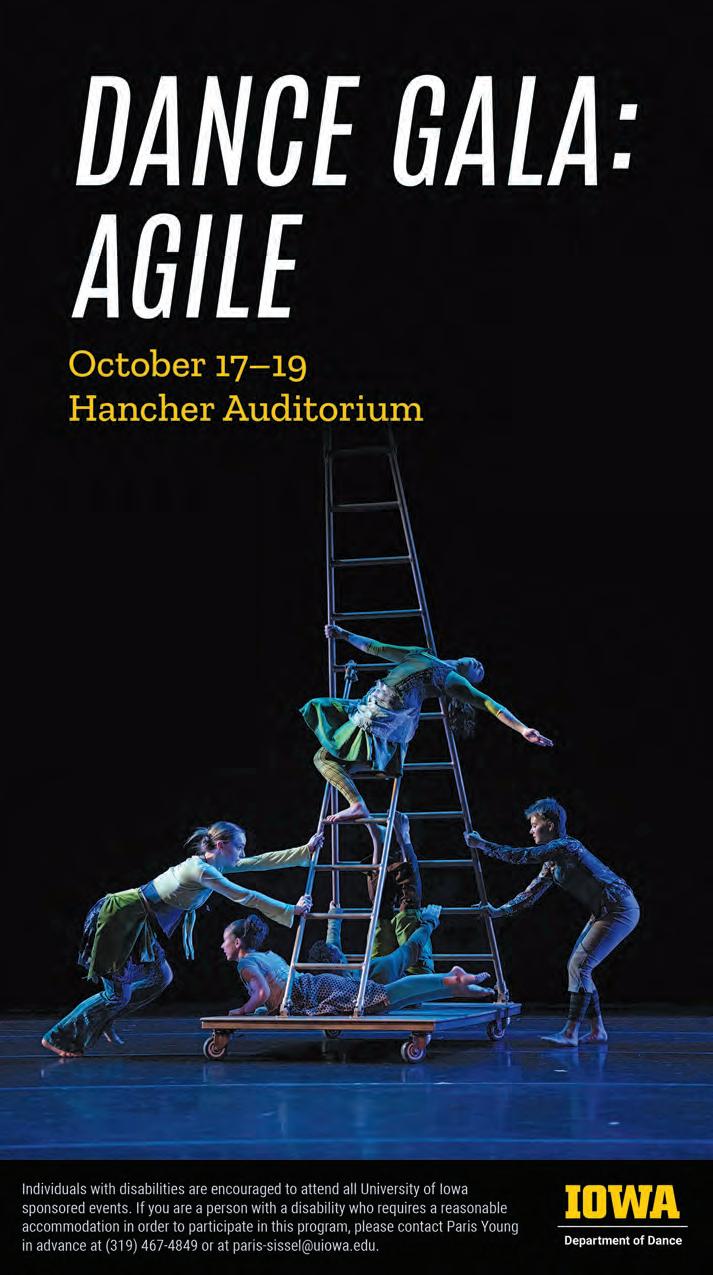
Ethan McLaughlin | The Daily Iowan
The top three fundraisers of the event pose for a photo following the University of Iowa Extra Life Charity Challenge: College Football 25 tournament held in the Kinnick Stadium Ted Pacha Family Club on Sept. 28. In total, the event raised 61,900 dollars for the University of Iowa Stead Family Children’s Hospital.
Decorated Iowa alumni discuss program experience
Cisneros, Harjo, and Herrera say the Writers’ Workshop changed for the better since their time at Iowa.
Isabelle Lubguban Arts Reporter arts@dailyiowan.com
Sandra Cisneros, Joy Harjo, and Juan Felipe Herrera spoke at the University of Iowa on Sept. 27. All three panelists graduated from the Writers’ Workshop, and Cisneros and Harjo were in the program at the same time.
The Latino-Native American Alumni Alliance hosted the panel to celebrate over 50 years of the organization’s work. Cisneros is an awarded author known for novels and short story collections such as “The House on Mango Street.” Harjo, a poet, musician, playwright, and author, was the first Native American poet laureate. Herrera is an educator, poet, and writer who uplifts Chicanx culture, amplifying shared experiences of solidarity and empowerment through poetry and prose for all. On Oct. 1, Herrera was named one of the 2024 MacArthur Fellows. This interview has been edited for length and clarity.
The Daily Iowan: How were your overall experiences in the Iowa Writers’ Workshop?
Sandra Cisneros: There was behavior there that would be unacceptable now. The students have told me that they don’t feel sexually harassed or abused, now. That’s not the workshop I knew. It was also constructed in a way that there was competitiveness and a hierarchy. I just feel like it’s a different workshop.
Joy Harjo: It’s quite different from the late ‘70s. I felt pretty silenced.
Juan-Felipe Herrera: I have been writing since 1966, performing, doing street theatre, spoken word, and traveling with poetry, Teatro Chicano, and so on. The Iowa Writers’ Workshop was my second world of poetry, a most exhilarating one.
How has the Iowa Writers’ Workshop changed since then?
Cisneros: The receptiveness of the students and the respect and the energy. The vibe you feel now is really different.
Harjo: The atmosphere in the workshop is much more, I would say respectful. Today my experience in the Writers’ Workshop was excellent and the students, you know, the advanced practice students, were open and interactive.
Herrera: The scene is different — new shops, new populations. My professors have passed away, the hangouts are also gone.
A new generation is on the move.
Do you feel that it helped push you guys to become better at your respective crafts?
Harjo: Definitely. Because of the workshop and my experience, I went through a period of trying to be somebody other than I was in my writing to match the kind of writing I was seeing, which worked for others, but not me. I came from a different culture, from a different community.
I had to stop and realize that I was there because of my writing and what I had to offer. I had to stay with it, follow it and make it through. So, it galvanized me and challenged me to keep moving in my own direction and not take on someone else’s.
Cisneros: One of the things that it taught me is that if your writing can withstand this criticism, then it’s going to make you write your very best before you put it out there. I realized as a person of color, we couldn’t afford to be good. We had to be excellent. It was a boot camp of sorts, but I didn’t think it needed to be structured hierarchically.
I was very intimidated and very easily silenced, but I had an
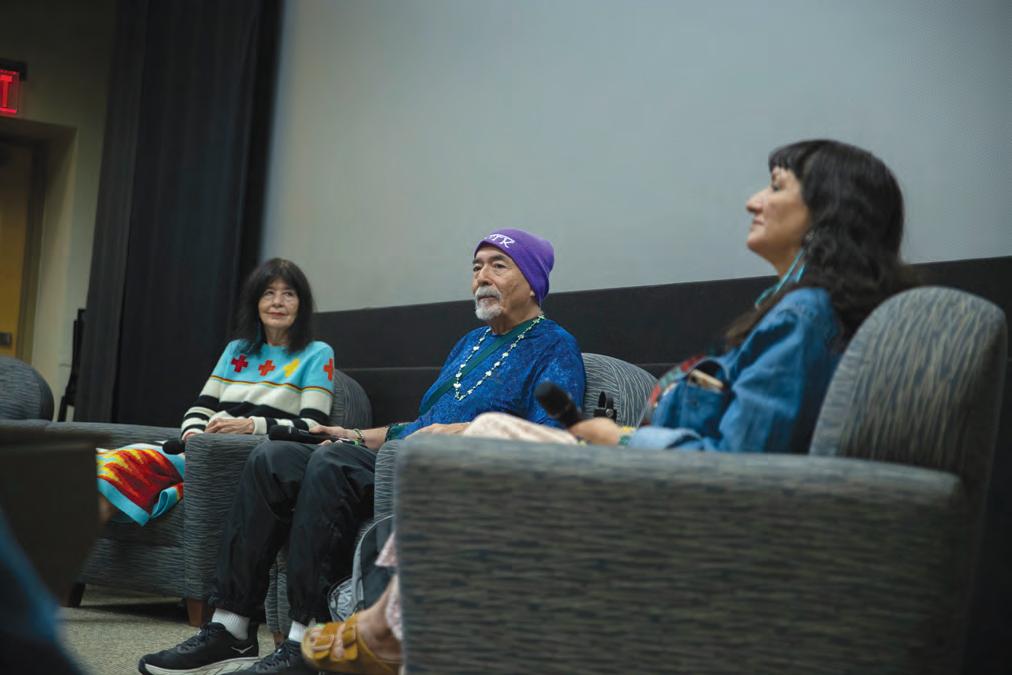
awakening when I was here thanks to the negative experience at the workshop. My first impulse when I realized my class difference was kind of shocking. I had been through all my years of education, and we never talked about class. So, it made me question whether I was smart enough or good enough to be here. What would be the best piece of advice that you guys can give to any prospective writer who is thinking about applying to the Iowa Writers’ Workshop?
Cisneros: You don’t often know who “yourself” is at 21. I wish that someone had made me look inside and see who I was. I had to discover who I was by coming here because I had never been anywhere except with my family. I didn’t know that the thing that made me different was the gift that I could give my writing. For women especially, you’re so used to meeting other people’s ideas of what they want you to be. Nobody has ever asked you in our society since it’s patriarchal, “What do you want?” And you don’t even know what you want. You discover that in your twenties. So, it’s an exciting time for women to figure out how to be themselves and who they are. Discovering that in your twenties is dangerous and devastating and exhilarating and wonderful and fun. Everything, all the emotions. It’s a magical, mystical journey. Harjo: Be yourself. Within us, we are built in to be exactly who we are. And where we get into trouble is when we contort ourselves to be someone other than we’re meant to be. Herrera: Enter with total happiness, experiment, and [have a] joy of life. Be ready to meet a new and exciting cohort of young writers, soon-to-be mentors, and friends.
What were your biggest inspirations while writing for the workshop?
Cisneros: When you read about your community, it’s not written about with love or accuracy, and I realized, I was gonna write that book. I wasn’t gonna get any credit for writing that book because I was in the poetry workshop, but I would write it as a way to keep my spirit alive during the time I was here. So, I started writing my poems and my prose pieces, the book that became “The House on Mango Street” here. Then I found a voice that was mine, not imitating anyone else’s in the workshop. It was a rage that made me ask myself, “What do I know that no one else knows?” Once I left here with the beginning of “The House on Mango Street” and a poetry manuscript, I went directly to work in the Tulsa neighborhood, the Mexican neighborhood in Chicago. My students began to populate my story, so it changed. I was compelled to write from a place of rage, but I composted it, and it transformed itself, opening a path for my writing.
Harjo: You have your tribal nation identity, but you’re also experimenting in the middle of it all, too. It was always important for me that the work speaks to the people. You can read it and understand that at the same time, you’re pushing the art and what the art can do within the parameters of cultural structures and at the same time creating what the generations need now because times have changed.
Herrera: I was inspired by Tadeusz Różewicz, Witold Gombrowicz, Denise Levertov.

Isabella Tisdale | The Daily Iowan
Panelists (from left) Joy Harjo, Juan Felipe Herrera, and Sandra Cisneros speak during Latino-Native American Alumni
Alliance Reunion at the Iowa Memorial Union on Sept. 29. Native American and Latino speakers spoke at a panel and sand shared their experiences as Iowa graduates.
